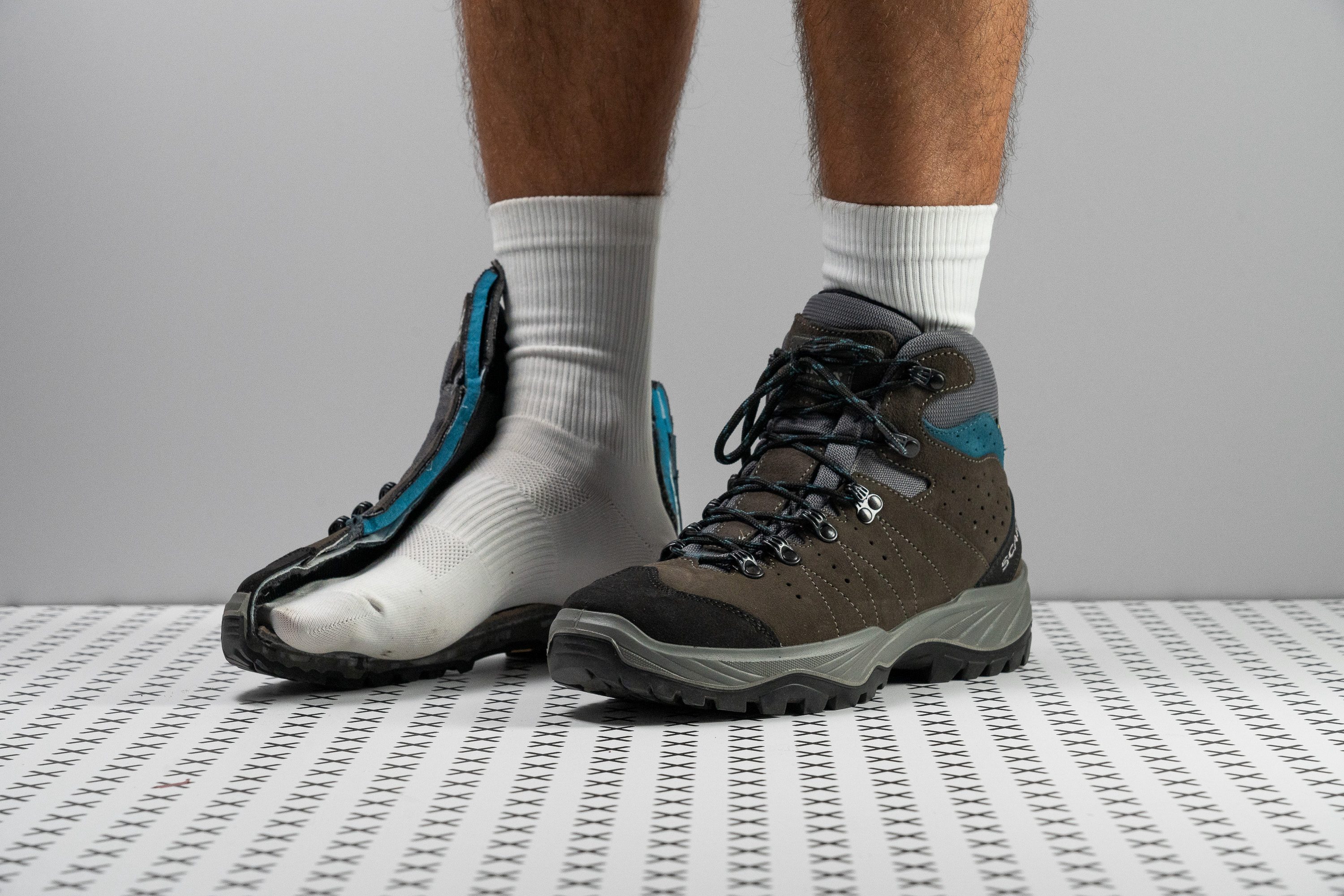Nuestra conclusión
Pros
- Impermeabilidad de primera
- Periodo de adaptación corto o nulo
- Excelente estabilidad y sujeción del tobillo
- Agarre fantástico en terrenos distintos
- Estructura duradera y resistente al desgaste
- Amortiguación para las rutas de todo el día
- Apenas le afectan las bajas temperaturas
Contras
- Más pesadas que la media
- No son aptas para pies anchos
Veredicto de los usuarios
Comparativa
Las botas de senderismo más parecidas
+ + Añadir unas zapatillas | |||||
|---|---|---|---|---|---|
| Puntuación global | 87 Notables | 95 Excelentes | 77 Aceptables | 90 Notables | |
| Precio | 210 € | 220 € | 210 € | 220 € | |
| Terreno de trail | ModeradoTécnico | ModeradoTécnico | ModeradoTécnico | Técnico | |
| Absorción de impactos | - | - | - | Moderada | |
| Retorno de energía | - | - | - | Alto | |
| Peso laboratorio Peso marca | 21 oz / 594g 21.2 oz / 600g | 20.3 oz / 575g 19 oz / 539g | 20.6 oz / 583g 20.6 oz / 585g | 21.1 oz / 597g 19.5 oz / 553g | |
| Transpirabilidad | Baja | Baja | Baja | Baja | |
| Uso | Senderismo de un díaNieve | Senderismo de un díaNieve | TrekkingSenderismo de un díaNieve | TrekkingSenderismo de un díaNieve | |
| Orthotic friendly | ✓ | ✓ | ✓ | ✓ | |
| Drop laboratorio | 15.8 mm | 15.1 mm | 14.0 mm | 17.2 mm | |
| Talla | Tallan bien | Tallan bien | Tallan un poquito pequeño | Tallan bien | |
| Rigidez de la mediasuela | Equilibrada | Equilibrada | Equilibrada | Equilibrada | |
| Diferencia de la rigidez de la mediasuela en frío | Pequeña | Pequeña | Pequeña | Pequeña | |
| Rigidez del contrafuerte del talón | Moderada | Moderada | Moderada | Flexible | |
| Flexibilidad | Rígida | Rígida | Moderada | Moderada | |
| Dureza de la suela | Estándar | Dura | Dura | Estándar | |
| Impermeabilización | Impermeables | Impermeables | Impermeables | Impermeables | |
| Material | Ante | Piel o cuero | Ante | Piel o cuero | |
| Estación | Invierno | Invierno | Invierno | Invierno | |
| Durabilidad de la parte delantera | Buena | Buena | Buena | Buena | |
| Durabilidad del acolchado del talón | Baja | Media | Media | Media | |
| Durabilidad de la suela exterior | Decente | Decente | Buena | Decente | |
| Anchura / ajuste | Ancha | Media | Media | Media | |
| Anchura de la parte delantera | Estrecha | Estrecha | Estrecha | Estrecha | |
| Profundidad del dibujo de la suela | 5.0 mm | 4.0 mm | 4.0 mm | 5.1 mm | |
| Altura de la suela en la zona del talón laboratorio | 34.6 mm | 32.1 mm | 34.2 mm | 37.8 mm | |
| Antepié | 18.8 mm | 17.0 mm | 20.2 mm | 20.6 mm | |
| Anchuras disponibles | Estándar | Estándar | Estándar | EstrechoEstándarAncho | |
| Tecnología | Gore-TexVibram | Gore-TexVibram | Gore-TexVibram | Gore-TexVibram | |
| Cut | Corte alto | Corte alto | Corte medio | Corte medio | |
| Removable insole | ✓ | ✓ | ✓ | ✓ | |
| Clasificación | #19 Top 47% | #1 Top 3% | #39 4% inferior | #7 Top 18% | |
| Popularidad | #40 2% inferior | #21 48% inferior | #41 1% inferior | #18 Top 44% |
Quién debería comprárselas
Las Mistral GTX son unas botas de senderismo sólidas a las que deberías echarle un ojo si estás buscando:
- Unas botas muy duraderas para las rutas de senderismo de media distancia en terrenos mixtos.
- Unas botas impermeables con Gore-Tex de primera calidad para cuando llueve y hace frío.
- Unas botas resistentes que no requieren un periodo de adaptación y son cómodas desde el minuto 1.
- Unas botas muy estables con una buena sujeción del tobillo.
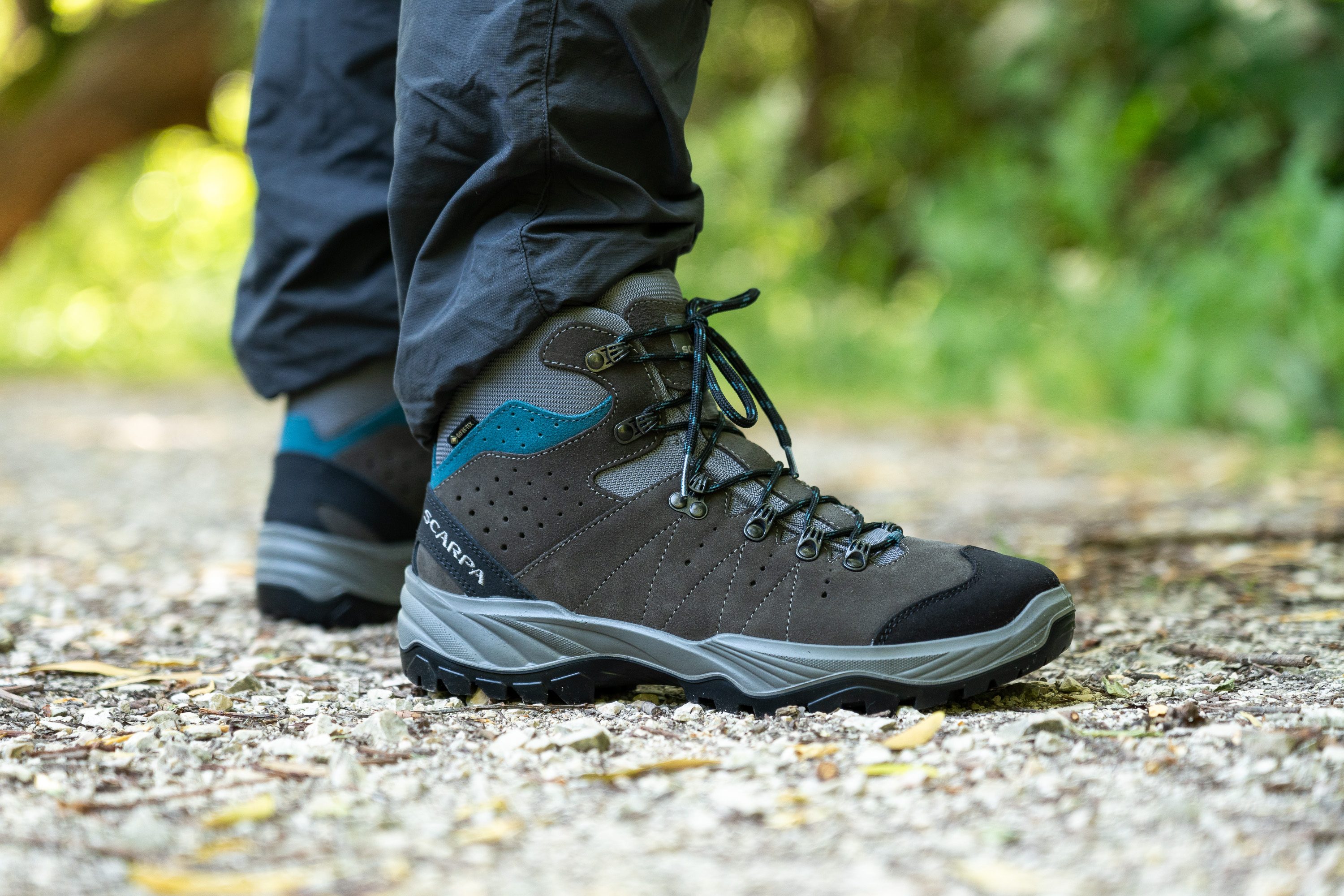
Quién NO debería comprárselas
Las Mistral GTX destacan en todas las cualidades esenciales de unas botas de senderismo, pero lo hacen pesando un poquito más de lo que deberían. La cosa es que hay bastantes botas igual de potentes que te pueden ofrecer la misma experiencia pero con un peso (y un precio) mucho más bajo, como las Salomon X Ultra 4 Mid GTX o las La Sportiva Ultra Raptor II Mid GTX.
También creemos que las personas con pies anchos estarán más contentas con la parte delantera más ancha que tienen las KEEN Targhee III Waterproof Mid o las Merrell Moab 3 Mid GTX.
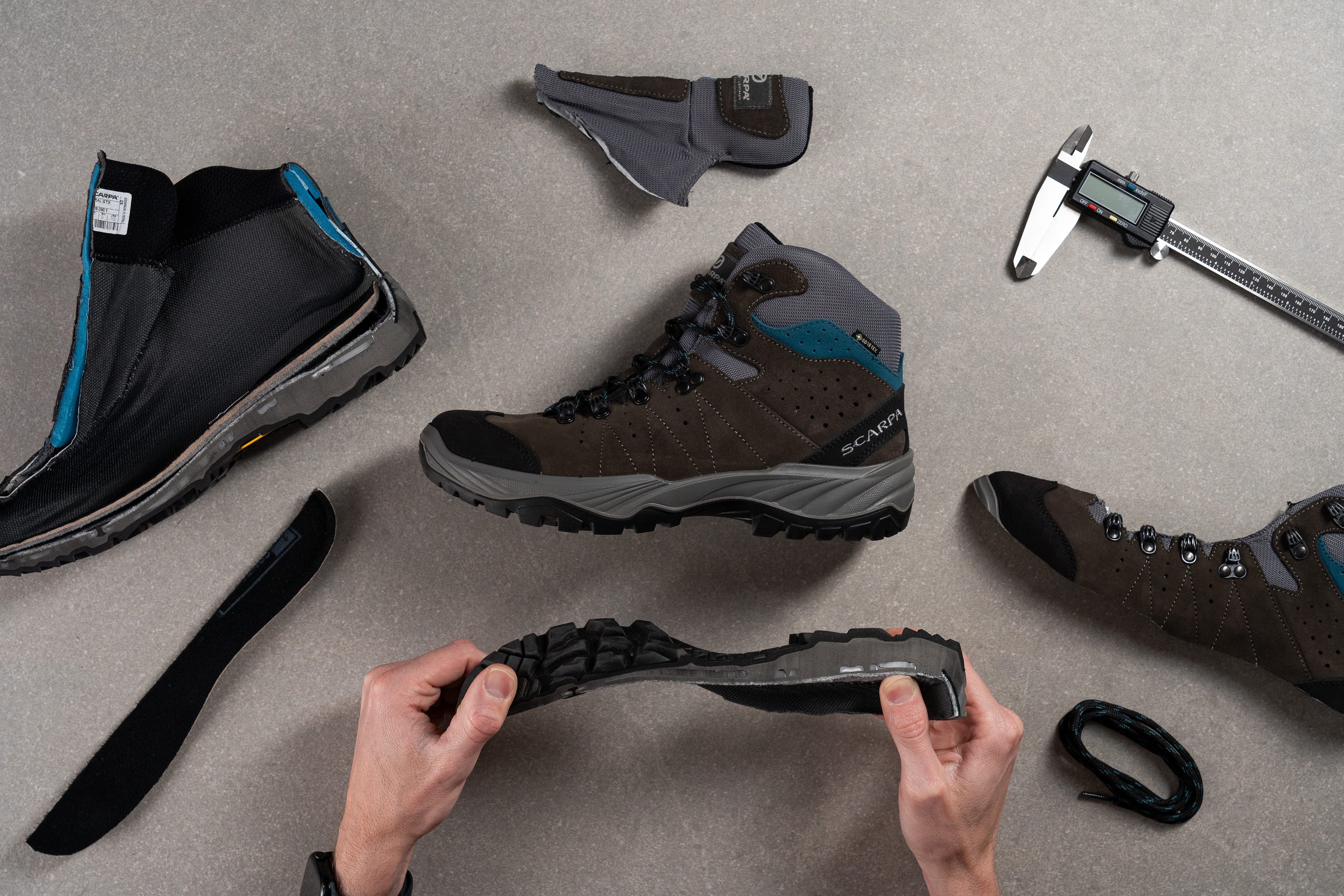
Amortiguación
Altura de la suela en la zona del talón
En nuestra opinión, las Mistral GTX tienen una amortiguación adecuada para ser unas botas de senderismo de un día. No es nada del otro mundo, pero tampoco nos quejamos.
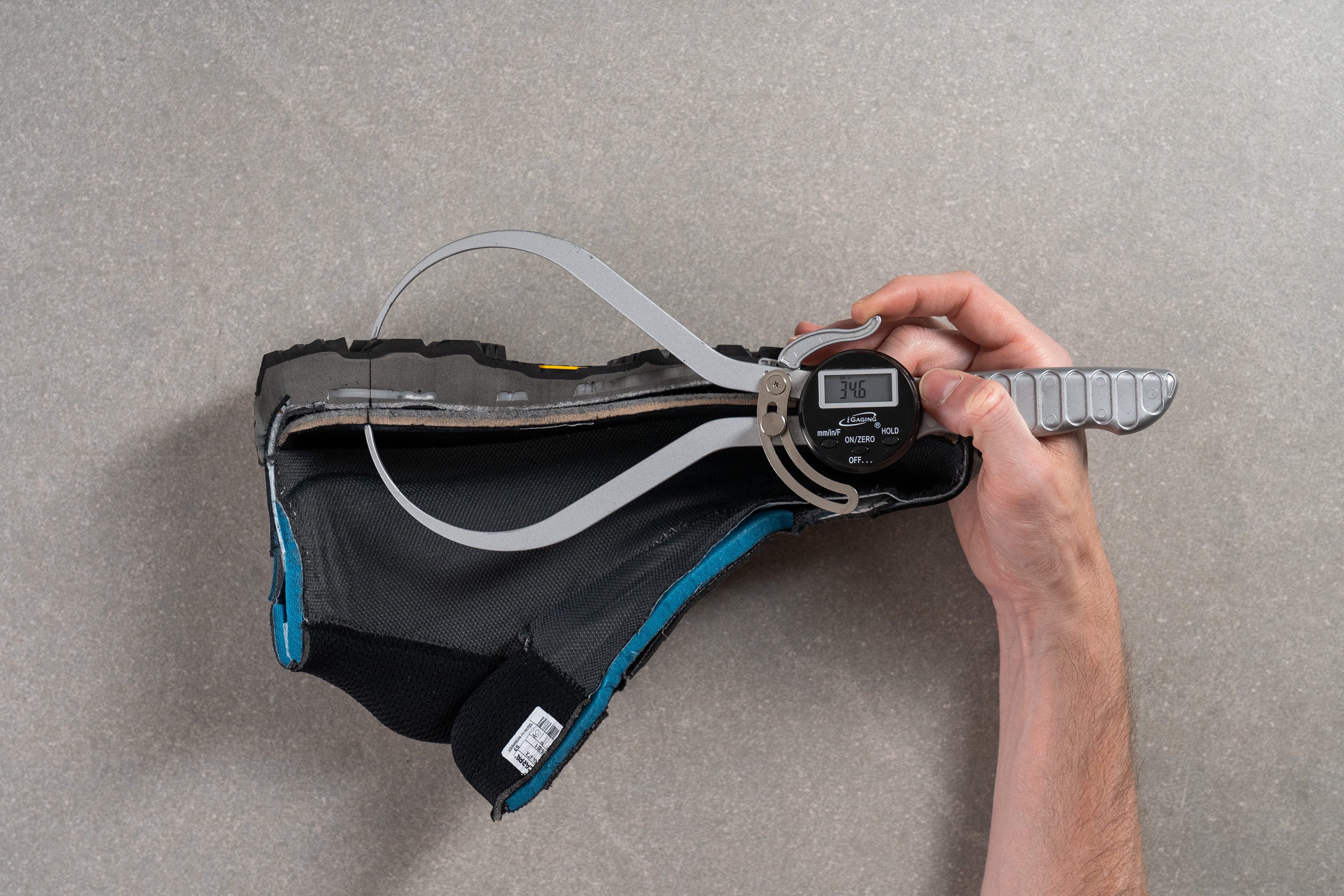
Cuando medimos la altura de la suela en el talón (plantilla y suela exterior incluidas), nuestro calibre marcó 34,6 mm. Esta plataforma tiene un grosor medio dentro de la categoría de las botas de senderismo, pero es suficiente para ofrecer protección contra impactos y aislar los pies de los obstáculos del trail.
| Mistral GTX | 34.6 mm |
| Media | 36.3 mm |
Altura de la suela en el antepié
También descubrimos que la suela de estas botas en el antepié es un poco más fina que la media, con 18,8 mm.

En nuestras pruebas de uso, sentimos que ese grosor ofrece un buen equilibrio entre protección y flexibilidad.
| Mistral GTX | 18.8 mm |
| Media | 23.0 mm |
Drop
Las Scarpa Mistral GTX tienen un drop bastante alto. La diferencia de los resultados al medir la altura de la suela en el talón y en el antepié nos dio 15,8 mm, que está en el lado más alto dentro del espectro de las botas de senderismo.
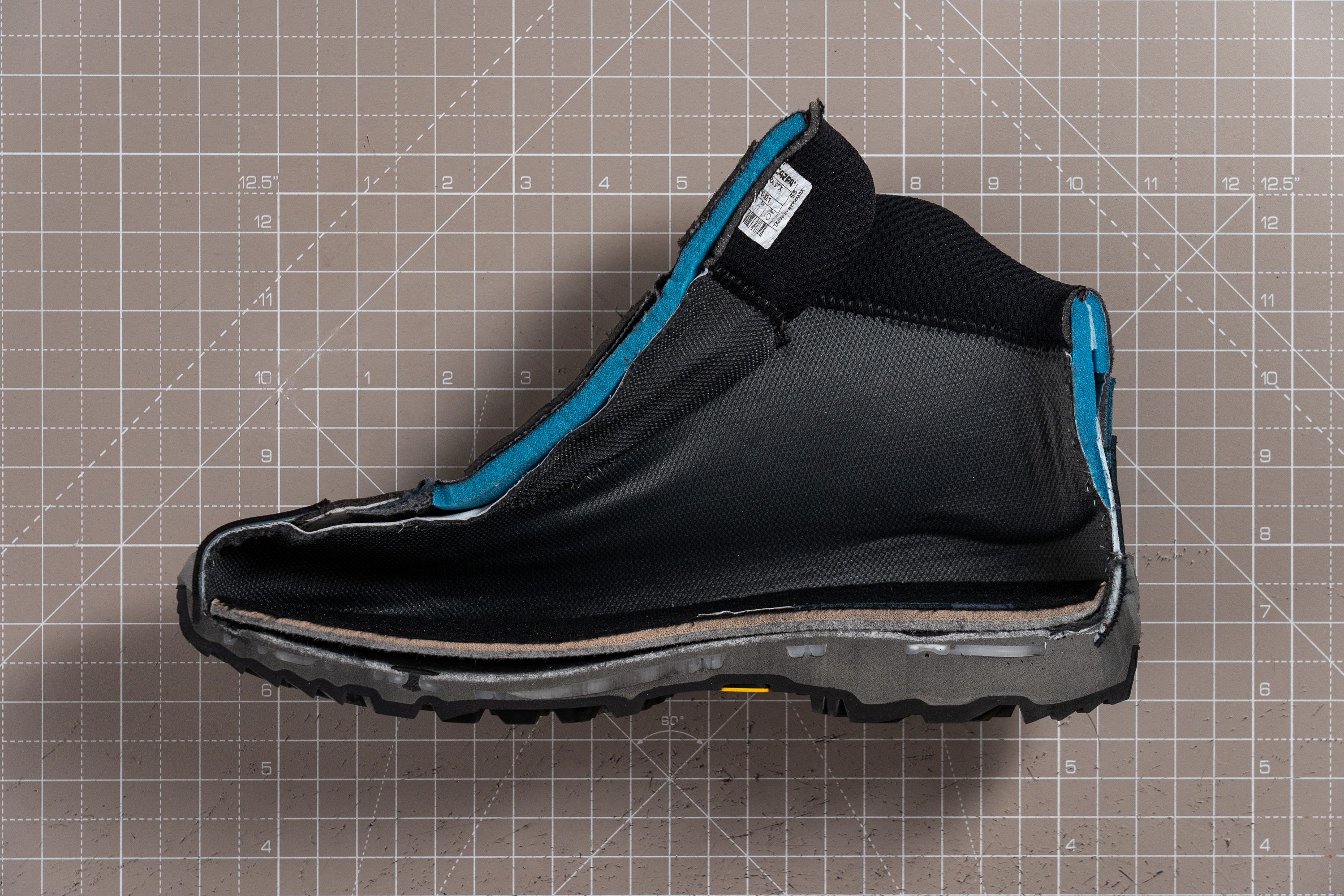
A menos que seas fan del calzado de senderismo con drop bajo o estilo barefoot, no creemos que tengas ningún problema con estas Scarpa. El talón alto ayuda a aliviar la presión sobre el tendón de Aquiles, sobre todo cuando llevas una mochila.
| Mistral GTX | 15.8 mm |
| Media | 13.3 mm |
Suavidad de la mediasuela
Las Mistral GTX se alejan bastante de ser mullidas, pero la amortiguación de su mediasuela tiene un toque de suavidad que proporciona un confort esencial.
Cuando presionamos nuestro durómetro contra la espuma principal de estas botas, marcó 24,8 HA, que es un resultado medio.
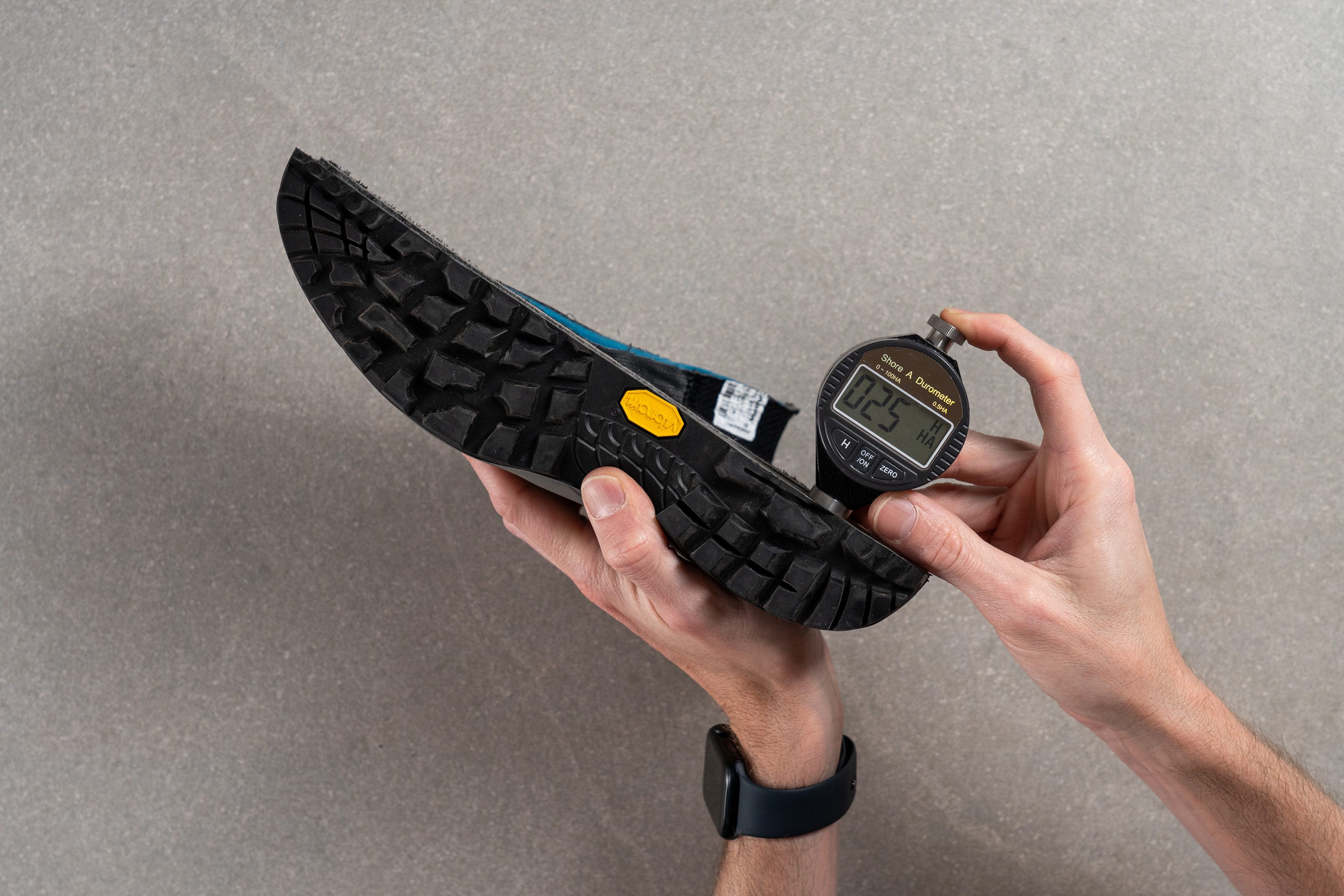
Eso sí, ten en cuenta que estas Scarpa se sienten bastante más firmes de lo que sugiere el resultado anterior por su cambrillón de TPU de longitud completa y el caucho firme de su suela exterior.
| Mistral GTX | 24.8 HA |
| Media | 28.4 HA |
Tallaje y ajuste
Talla
Las Scarpa Mistral GTX tallan bien (16 votos).
Anchura / Ajuste
En cuanto al ajuste en la zona de los metatarsos, descubrimos que las Mistral GTX ofrecen un espacio bastante razonable para ser de anchura media (D).
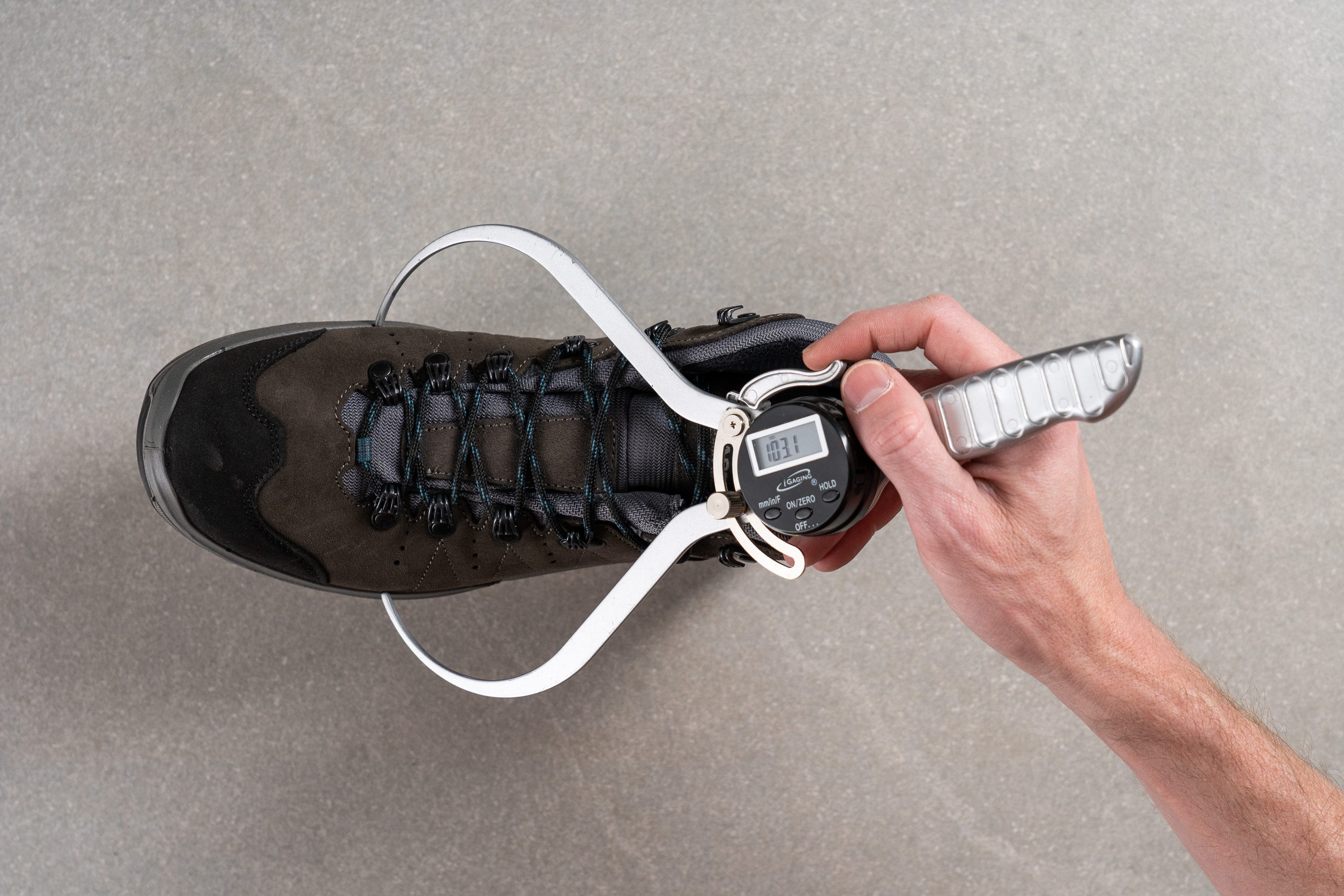
Nuestro calibre marcó 103,1 mm en el punto más ancho de la parte delantera, que es una medida estándar entre las botas de senderismo que hemos analizado en nuestro laboratorio.

En esta prueba se utiliza una metodología antigua, así que no verás las zapatillas que hemos analizado últimamente en la tabla. Los resultados obtenidos con metodologías distintas no se pueden comparar.
| Mistral GTX | 103.1 mm |
| Media | 102.1 mm |
Anchura de la parte delantera
Las Mistral GTX se estrechan un poco hacia la punta. Según nuestro calibre, miden 75,6 mm en la zona del dedo gordo, que es un poco menos que la media, pero nada preocupante.
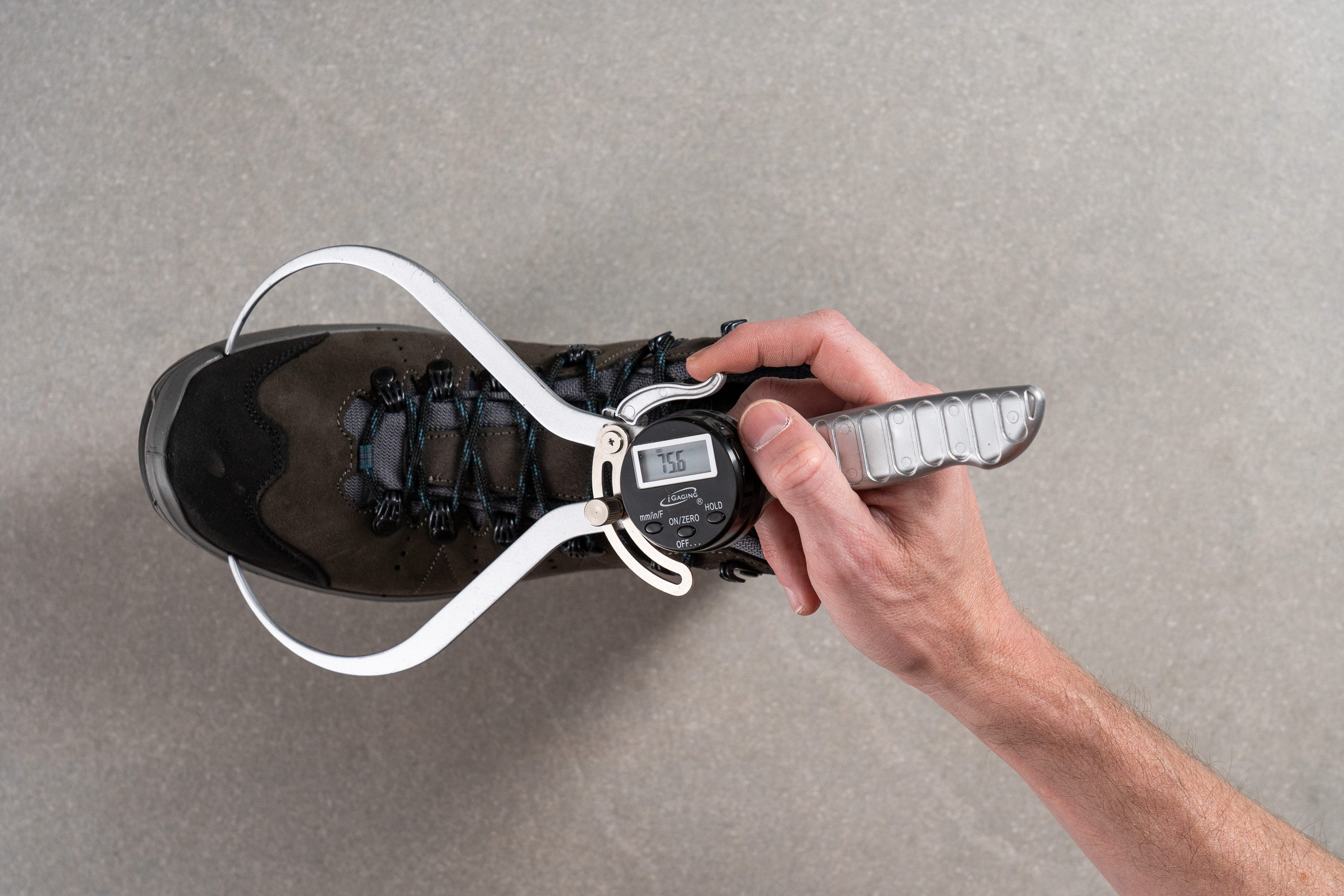
En esta prueba se utiliza una metodología antigua, así que no verás las zapatillas que hemos analizado últimamente en la tabla. Los resultados obtenidos con metodologías distintas no se pueden comparar.
| Mistral GTX | 75.6 mm |
| Media | 78.6 mm |
Cordones
Las Mistral GTX utilizan cordones redondos resistentes que tienen una longitud adecuada y que no se te desatan en las rutas.
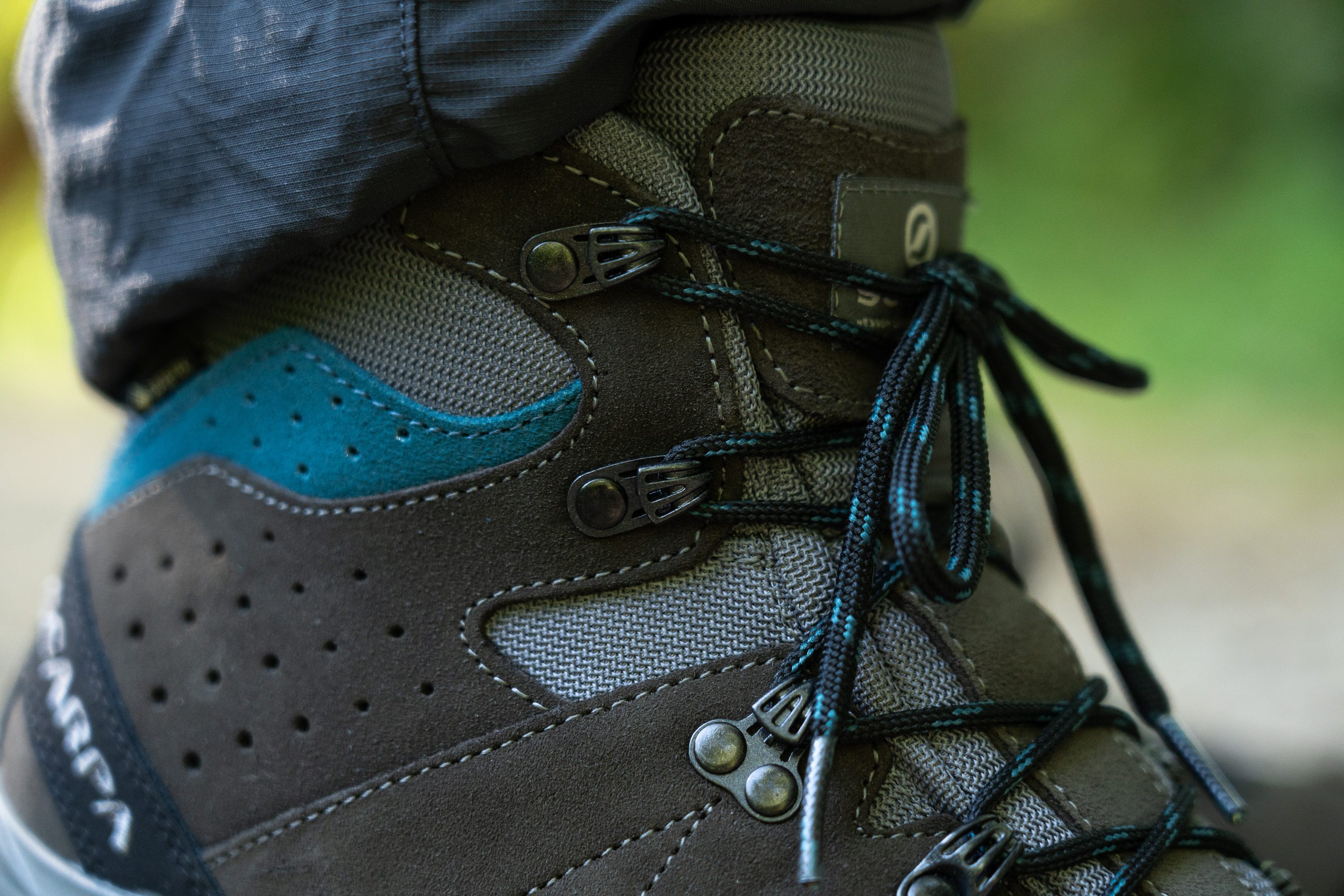
El cuello tiene 3 pares de ojales a modo de lazo para que calzarse sea más rápido y fácil.
Necesitan un periodo de adaptación
Una de las mejores cosas de estas Scarpa es que son cómodas desde el minuto 1, así que no requieren un periodo de adaptación largo o duro.
La primera vez que nos pusimos las Mistral GTX para hacernos una ruta larga, no terminamos ni con ampollas ni con rozaduras de ningún tipo.
Tracción / Agarre
Profundidad del dibujo de la suela
Las botas de Scarpa nunca decepcionan cuando hablamos de tacos con un buen agarre. Al fin y al cabo, en esta marca son expertos en el calzado de escalada y montañismo.
Nuestro calibre marcó 5,0 mm cuando medimos la profundidad de los tacos de las Mistral GTX. Como son más profundos que la media, hacen que estas botas sean adecuadas para los terrenos técnicos.
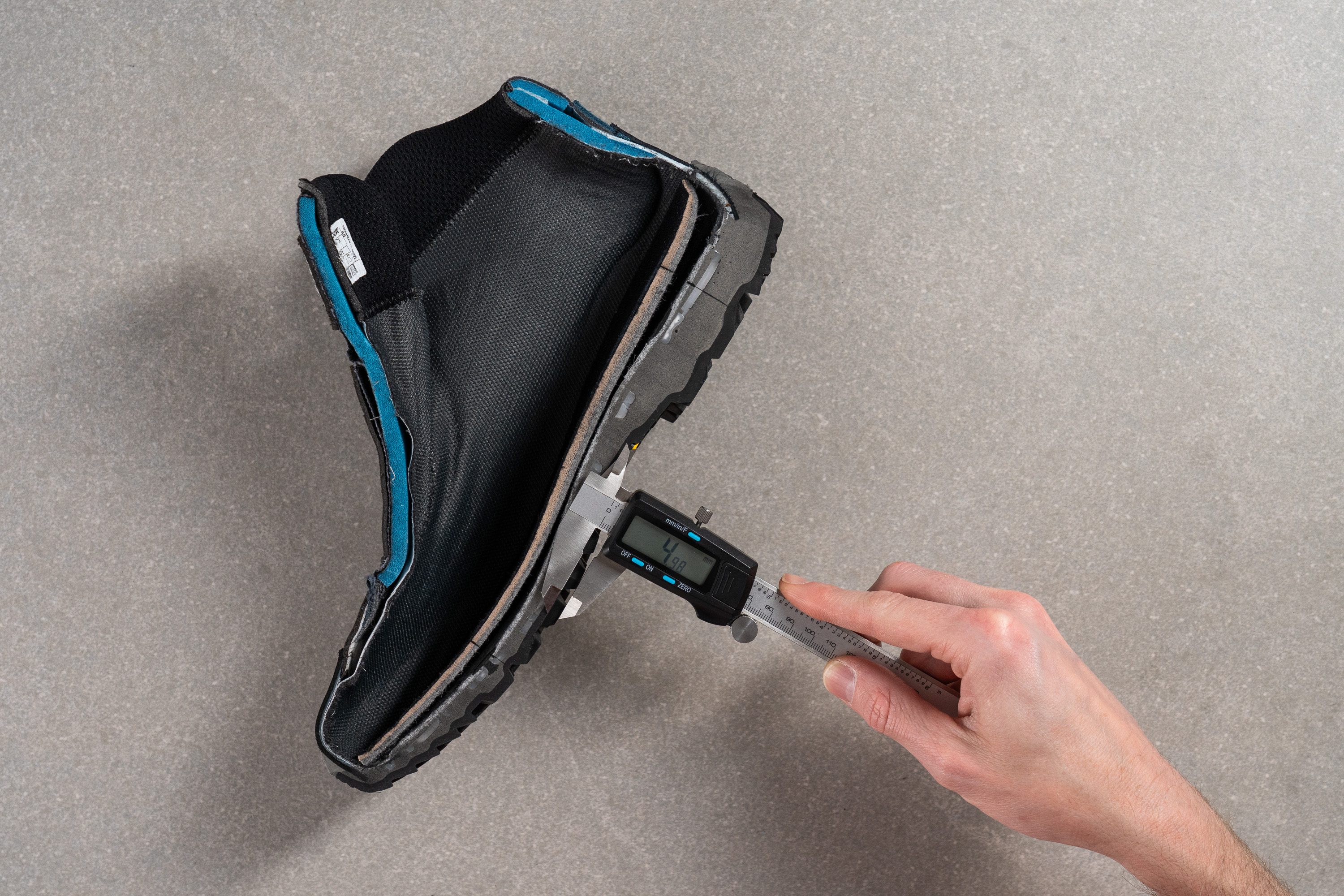
Pero no es solo la profundidad de los tacos lo que hace que estas Scarpa tengan tan buen agarre, su posicionamiento estratégico y su forma también juegan un papel importante.
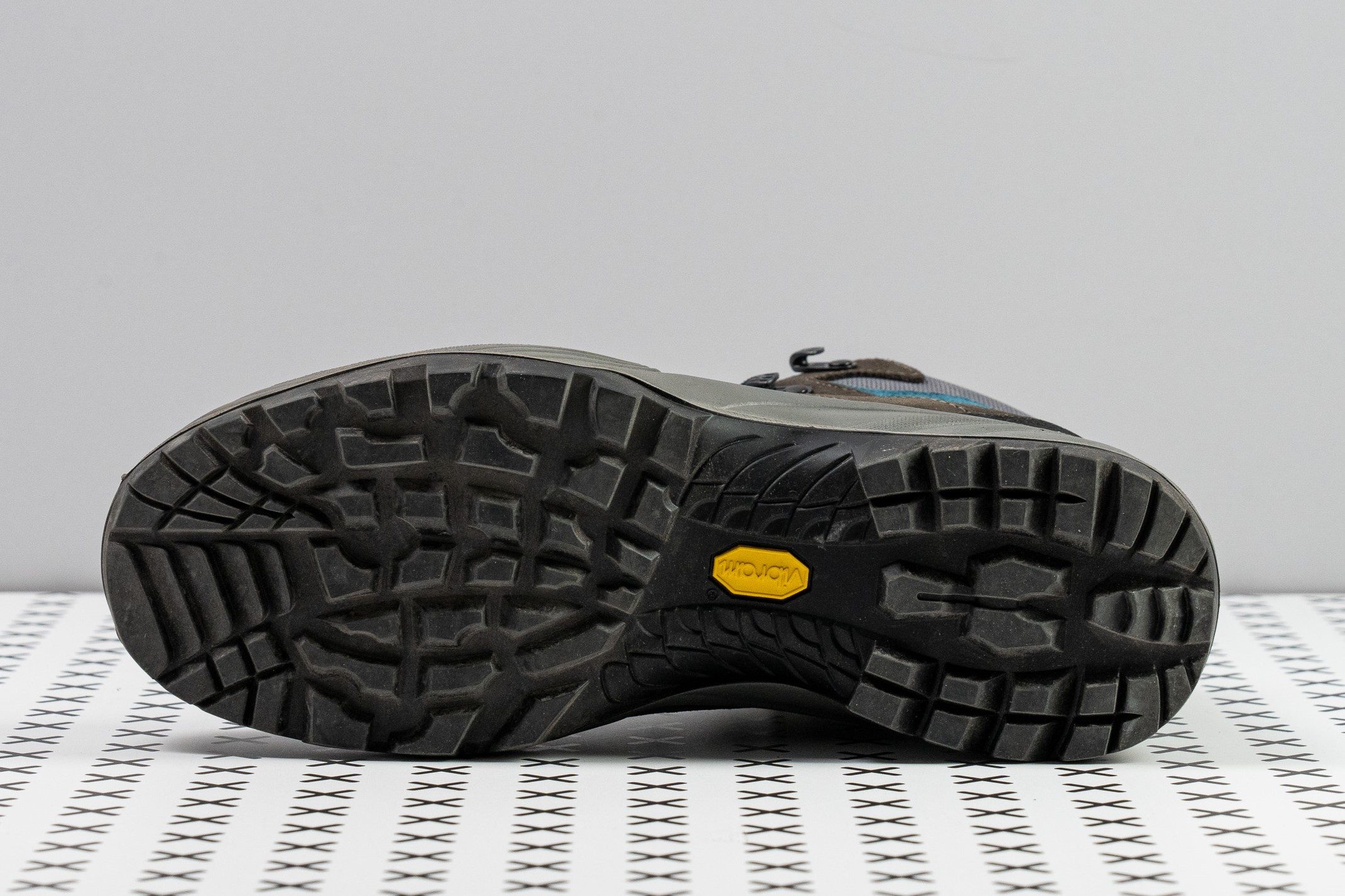
La zona que está más pegada a la punta tiene tacos afilados con forma de cuchilla para ofrecerte el máximo agarre en los ascensos. Vemos tacos parecidos en el talón para ayudarte a frenar en los descensos. Los tacos del antepié que están más espaciados también ayudan a avanzar por los terrenos blandos de manera más eficaz.
El freno que estas botas tienen en el talón también ayuda a que sea más fácil parar cuando vas cuesta abajo.
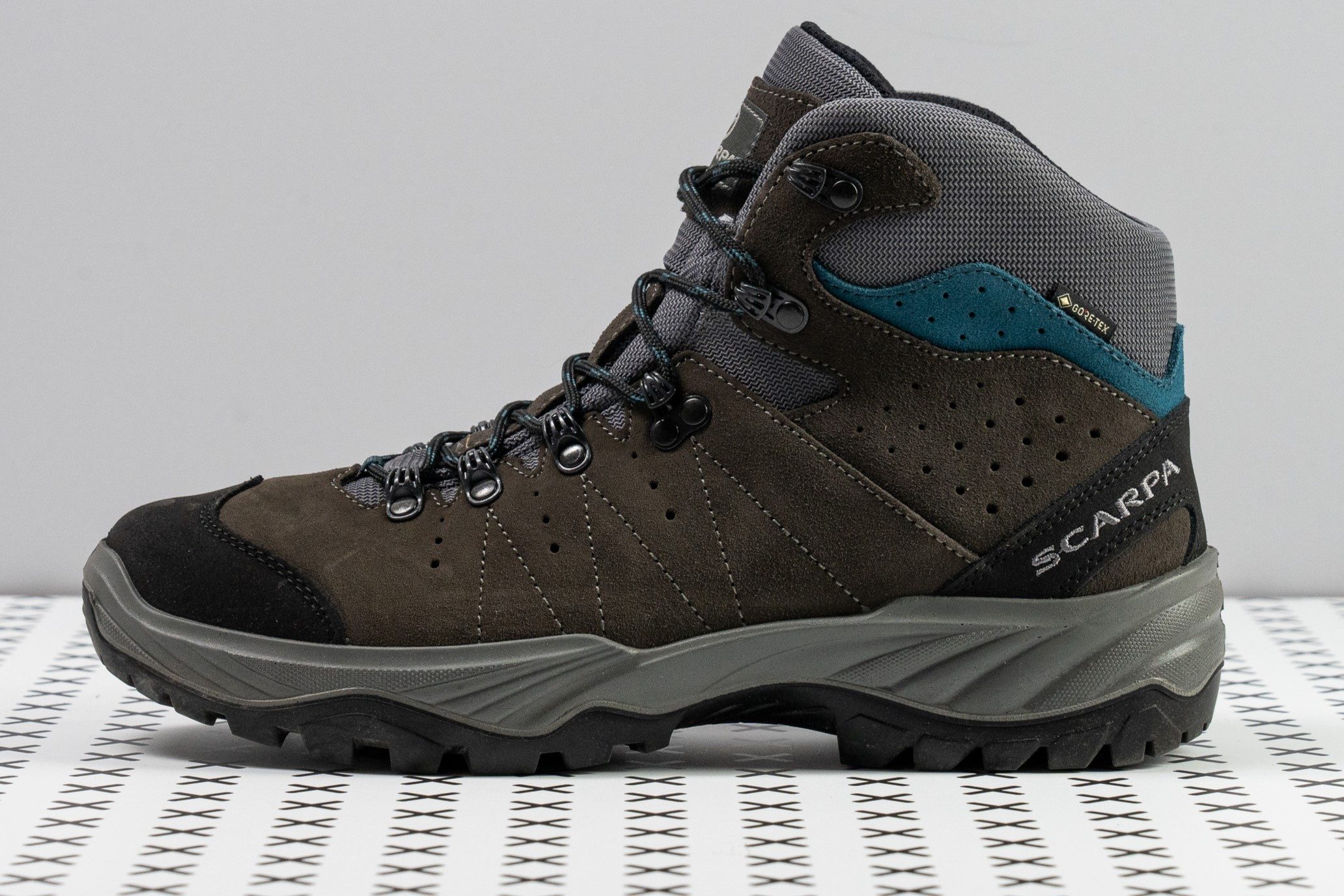
Estamos seguros de que las Scarpa Mistral GTX se pueden enfrentar a muchos terrenos distintos sin problema. Los que están llenos de piedras, raíces, troncos con musgo, arroyos y zonas pantanosas... ¡lo que se te ocurra!
| Mistral GTX | 5.0 mm |
| Media | 4.3 mm |
Flexibilidad / Rigidez
Con un rígido cambrillón de TPU que recorre toda la mediasuela de estas botas y su firme upper de ante, no nos esperábamos que las Mistral GTX se doblasen fácilmente.
Y no lo hicieron. De hecho, son incluso más rígidas que la media de las botas de senderismo según nuestra prueba de flexibilidad.
Necesitaron 48,5 N para doblarse hasta un ángulo de 90 grados, que es un 10 % más de fuerza que la media.
Que esto sea bueno o malo depende de tus preferencias personales. Aunque no son tan cómodas como las botas de Hoka, sí que son agradables y se sienten bien estructuradas en los pies.
En esta prueba se utiliza una metodología antigua, así que no verás las zapatillas que hemos analizado últimamente en la tabla. Los resultados obtenidos con metodologías distintas no se pueden comparar.
| Mistral GTX | 48.5N |
| Media | 44.3N |
Rigidez en frío (%)
Si te vas a comprar las Mistral GTX para cuando hace frío, ten en cuenta que se vuelven un poco más rígidas.
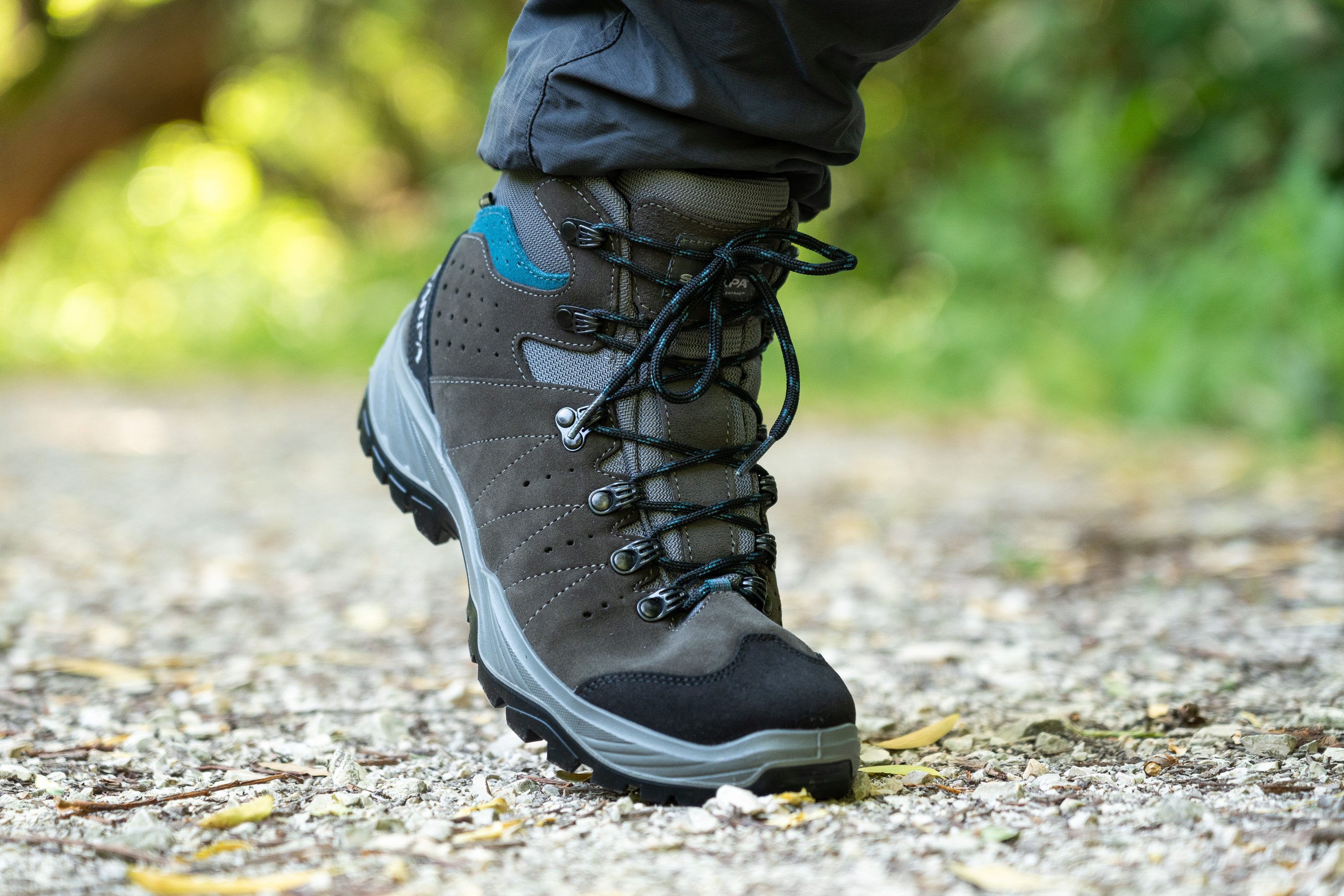
Después de pasarse 20 minutos en nuestro congelador, necesitaron un 11,7 % más de fuerza para doblarase 90 grados.
| Mistral GTX | 12% |
| Media | 24% |
Peso
Con solo echarles un ojo, probablemente ya sepas que las Mistral GTX son unas botas pesadas. Al final son tan robustas como sus compañeras de la misma marca.
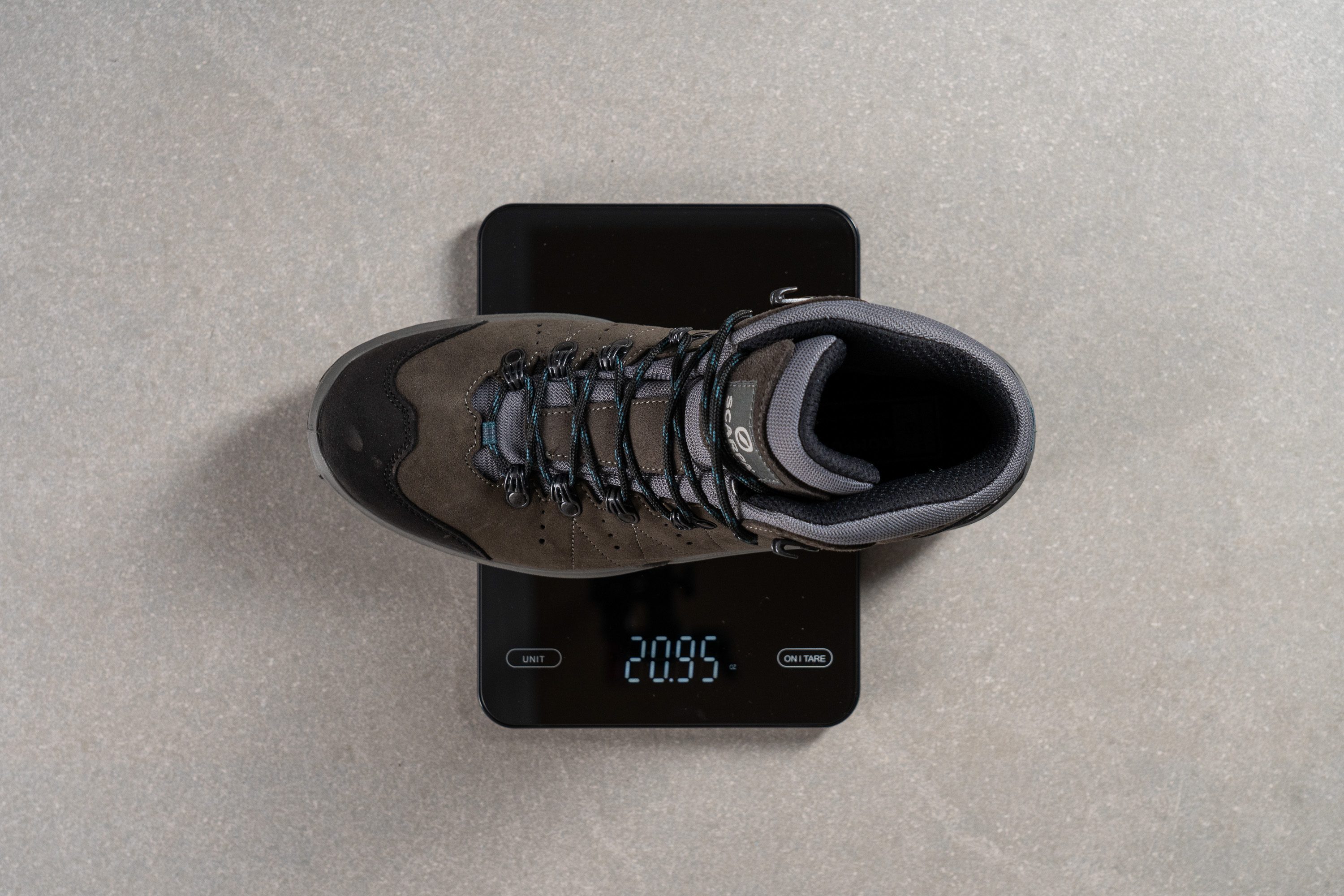
Con sus 594 g en una talla 9 estadounidense de hombre, pesan bastante más que la media de las botas de senderismo.
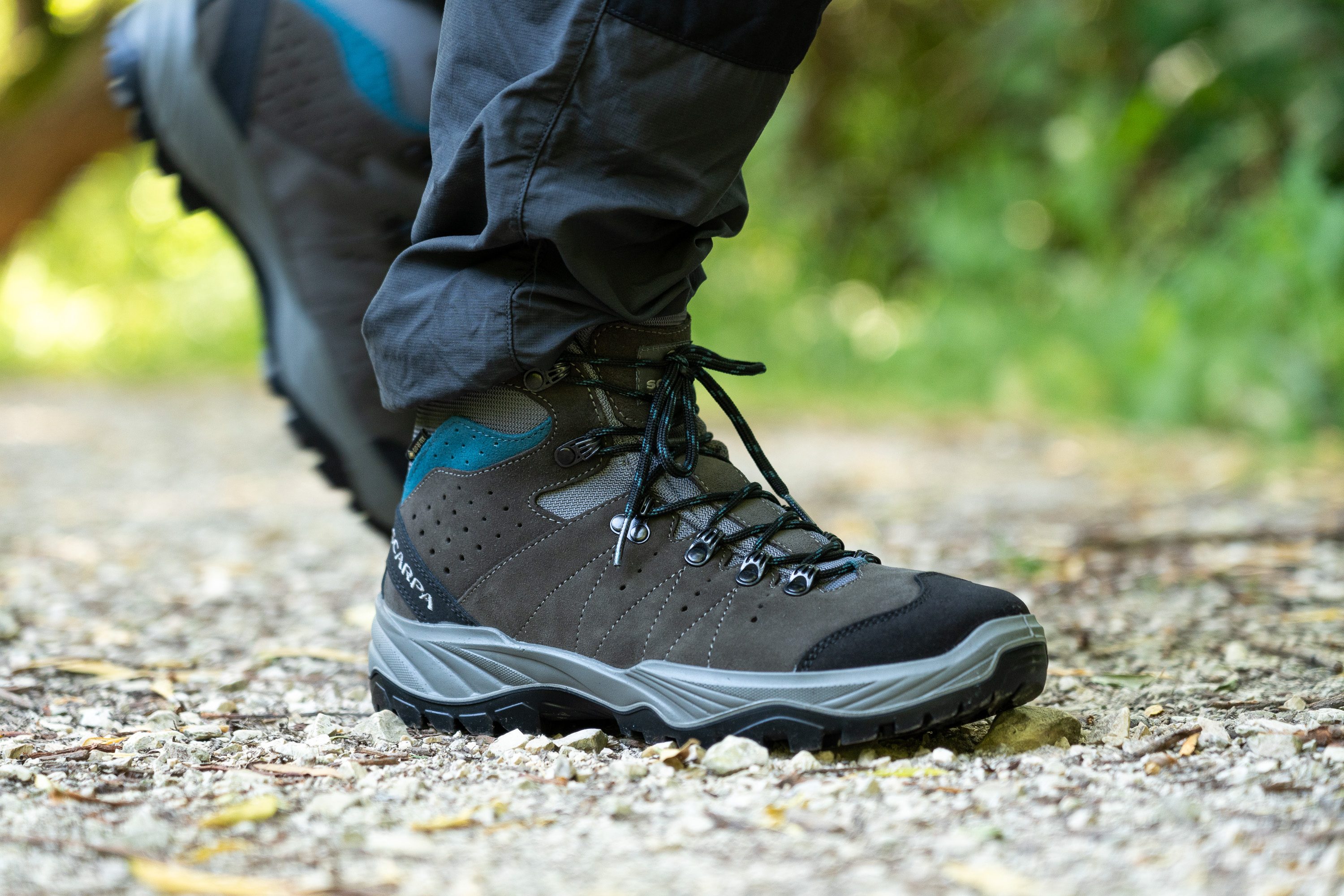
Eso sí, en comparación con otras botas de Scarpa que tienen una estructura parecida, solo pesan un poquito más. Por ejemplo, superan a las Rush TRK GTX (567 g), a las Terra GTX (575 g), y a las Boreas GTX (583 g), ¡pero tampoco por tanto!
| Mistral GTX | 21.0 oz (594g) |
| Media | 18.7 oz (531g) |
Transpirabilidad
Las Scarpa Mistral GTX nos han parecido perfectas para el invierno y los meses fríos en general. Sus interiores bien acolchados, su cuello de caña alta y su membrana impermeable hicieron que nuestros pies supiesen lo que es un abrazo de oso.
¿Que si en los abrazos de oso se puede respirar? Pues mira, la respuesta te la va a dar nuestra prueba de transpirabilidad. Cuando llenamos de humo las botas, no pudo salir ni un poquito.
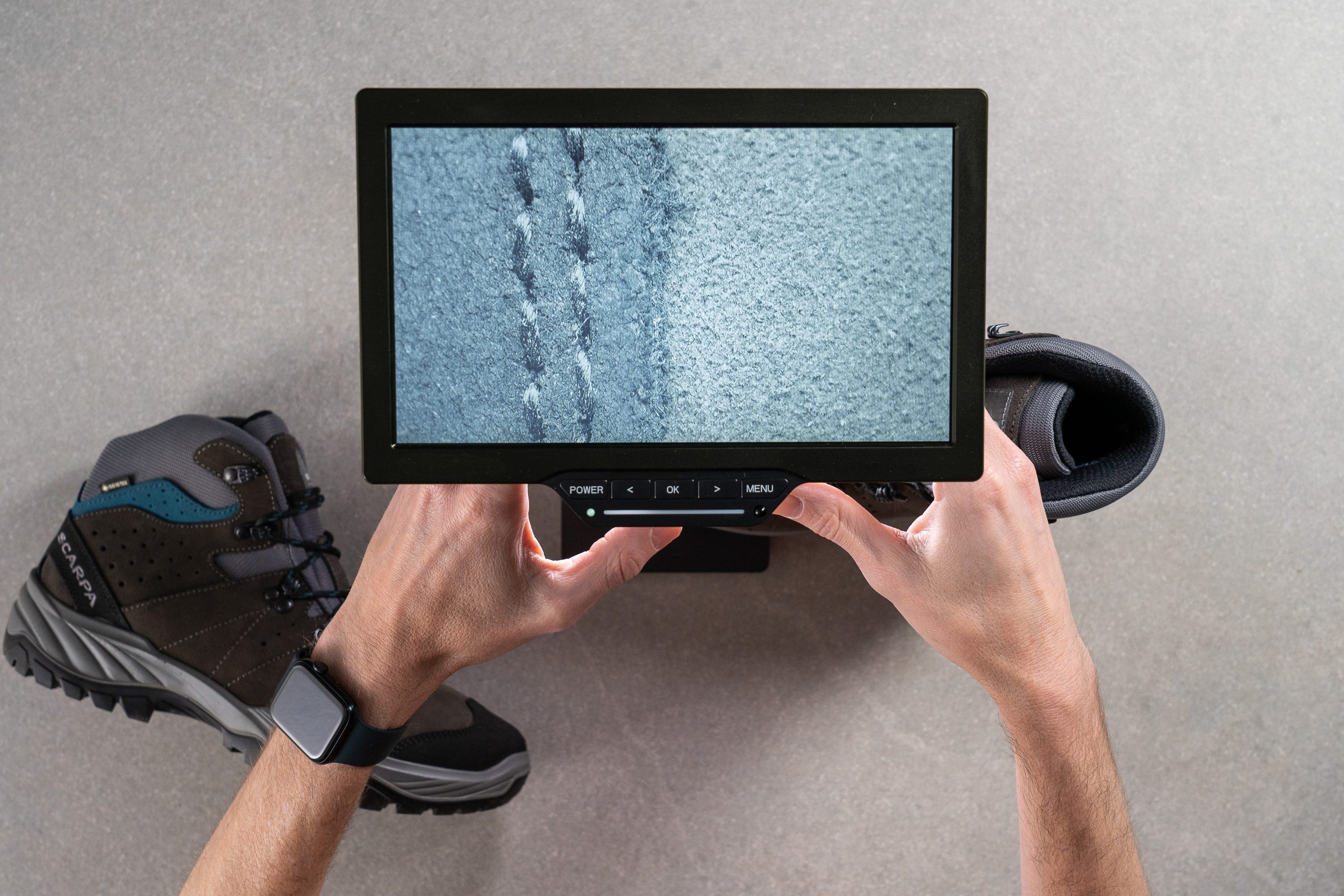
La parte delantera de estas Scarpa está hecha con ante sólido, así que no tiene ningún agujerito para que el aire entre y salga.
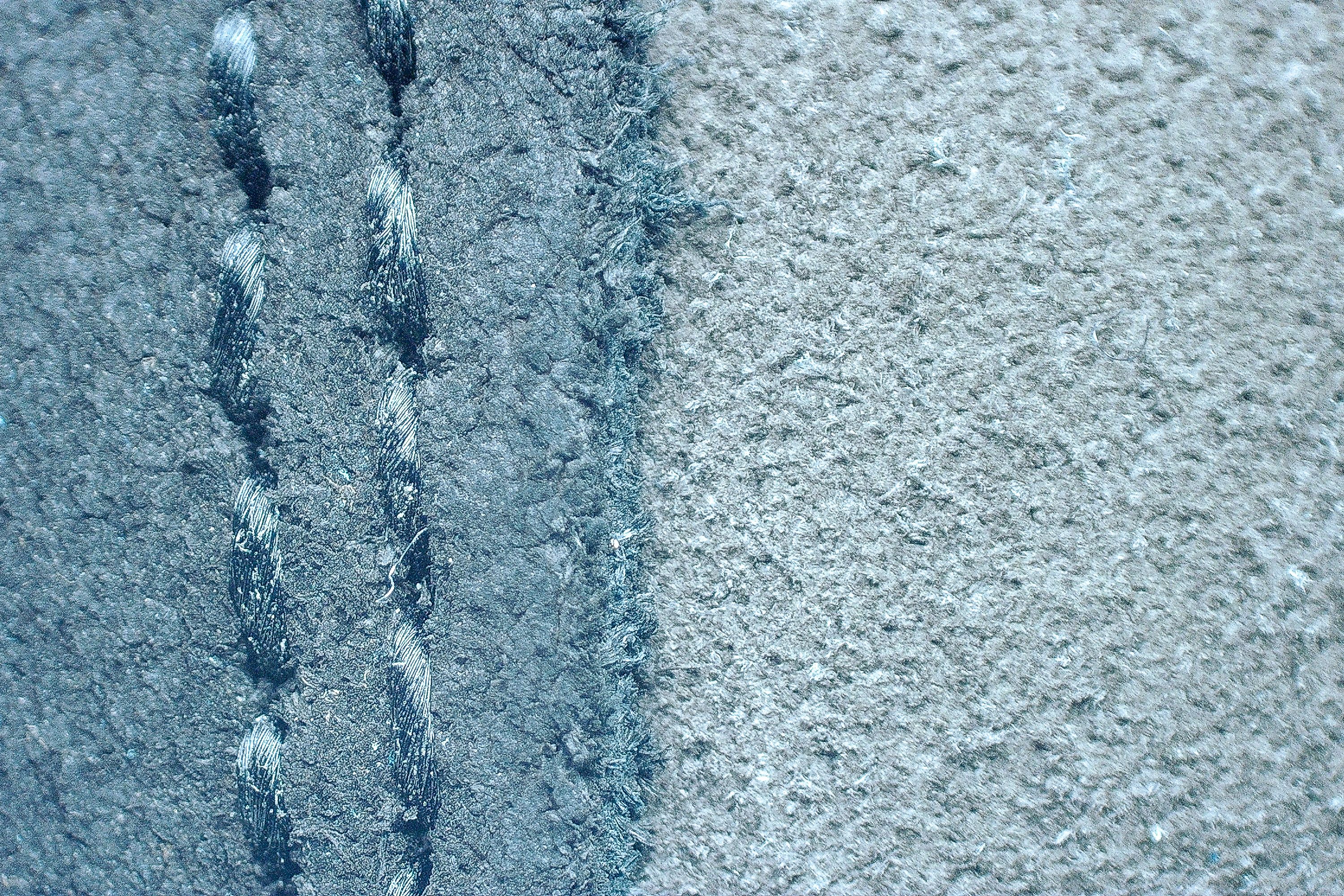
Por lo tanto, no dudamos ni un segundo en darles a las Mistral GTX nuestra puntuación más baja en transpirabilidad: un 1/5.
| Mistral GTX | 1 |
| Media | 1.3 |
Resistencia al agua
Hay dos componentes clave que son los responsables de la impermeabilidad de las Mistral: el ante resistente al agua que tienen fuera, y la membrana Gore-Tex impermeable que tienen dentro.
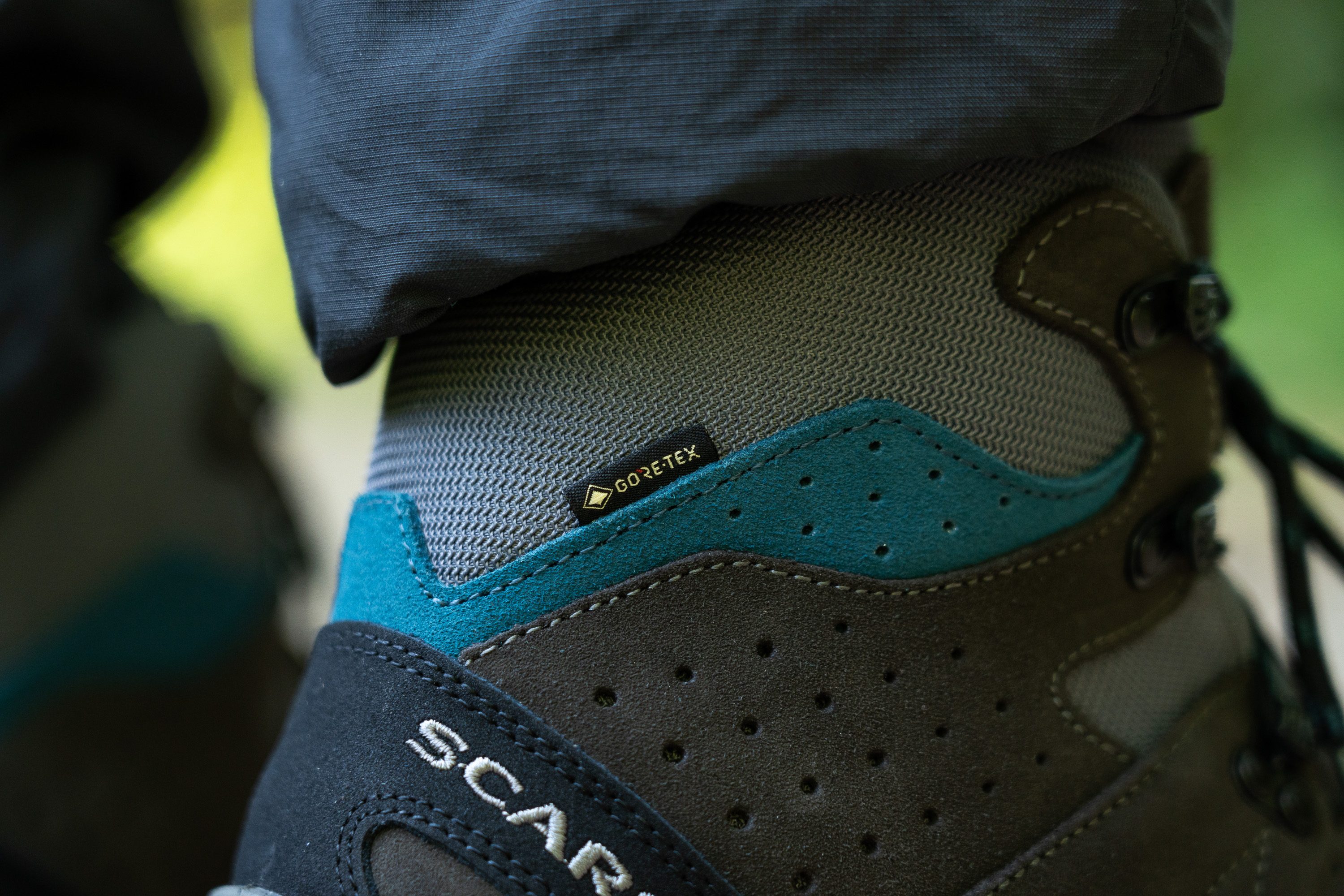
Después de haber analizado hasta el más mínimo detalle de estas Scarpa, podemos confirmarte que están preparadas para cuando te toca enfrentarte al agua. Ya sean charcos profundos, riachuelos, ciénagas, aguanieve, nieve o lluvia, puedes confiar en las Mistral GTX.
Estabilidad
Prueba de estabilidad lateral
La estabilidad y la contención lateral son algunas de las principales razones para comprarte las Mistral GTX. En serio, estas botas hicieron que todas nuestras preocupaciones despareciesen cuando nos adentramos en la montaña.
Este modelo está diseñado con la sujeción en mente: su mediasuela en forma de cuna, el cambrillón de TPU de longitud completa, el upper rígido de ante y el cuello por encima del tobillo trabajan en equipo para que el pie ni se mueva ni se tambalee.
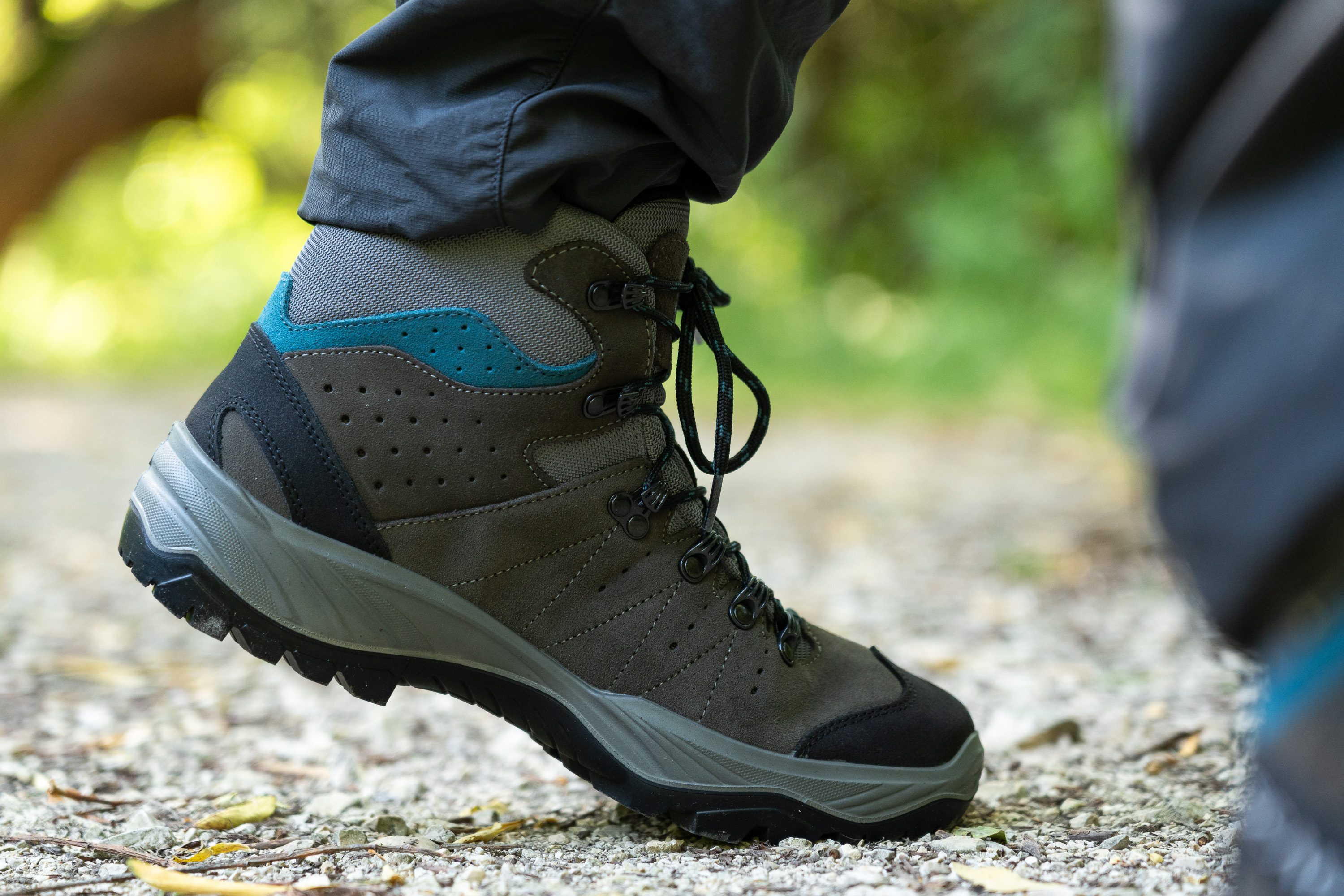
Rigidez torsional
Una alta rigidez torsional es una de las principales características de unas botas de senderismo estables. Por eso retorcemos cada par con nuestras propias manos, evaluando así lo rígida que es su estructura. Cuando más difícil sea de retorcer, menos probabilidades hay de que tu pie se doble con él puesto.
Con que le eches un ojo al vídeo que te dejamos por aquí arriba, entenderás por qué les hemos dado a las Mistral la máxima puntuación en rigidez torsional.
| Mistral GTX | 5 |
| Media | 4.4 |
Rigidez del contrafuerte del talón
Un contrafuerte de talón rígido es otro factor importante para la estabilidad de las botas y las Scarpa Mistral GTX lo tienen claro.
Cuando nos las pusimos, nuestros talones y tobillos se quedaron bien encajados en la parte de atrás, ¡y no se movieron de ahí!
Cuando empujamos el contrafuerte del talón de estas botas con las manos, nos costó tanto moverlo que decidimos darle un 4/5 en rigidez. Creemos que es un resultado adecuado para unas botas de senderismo de un día que no son demasiado técnicas.
| Mistral GTX | 4 |
| Media | 3.6 |
Anchura de la mediasuela - antepié
Para nuestra sorpresa, estas Scarpa ofrecen una experiencia muy estable sin tener una plataforma especialmente ancha.
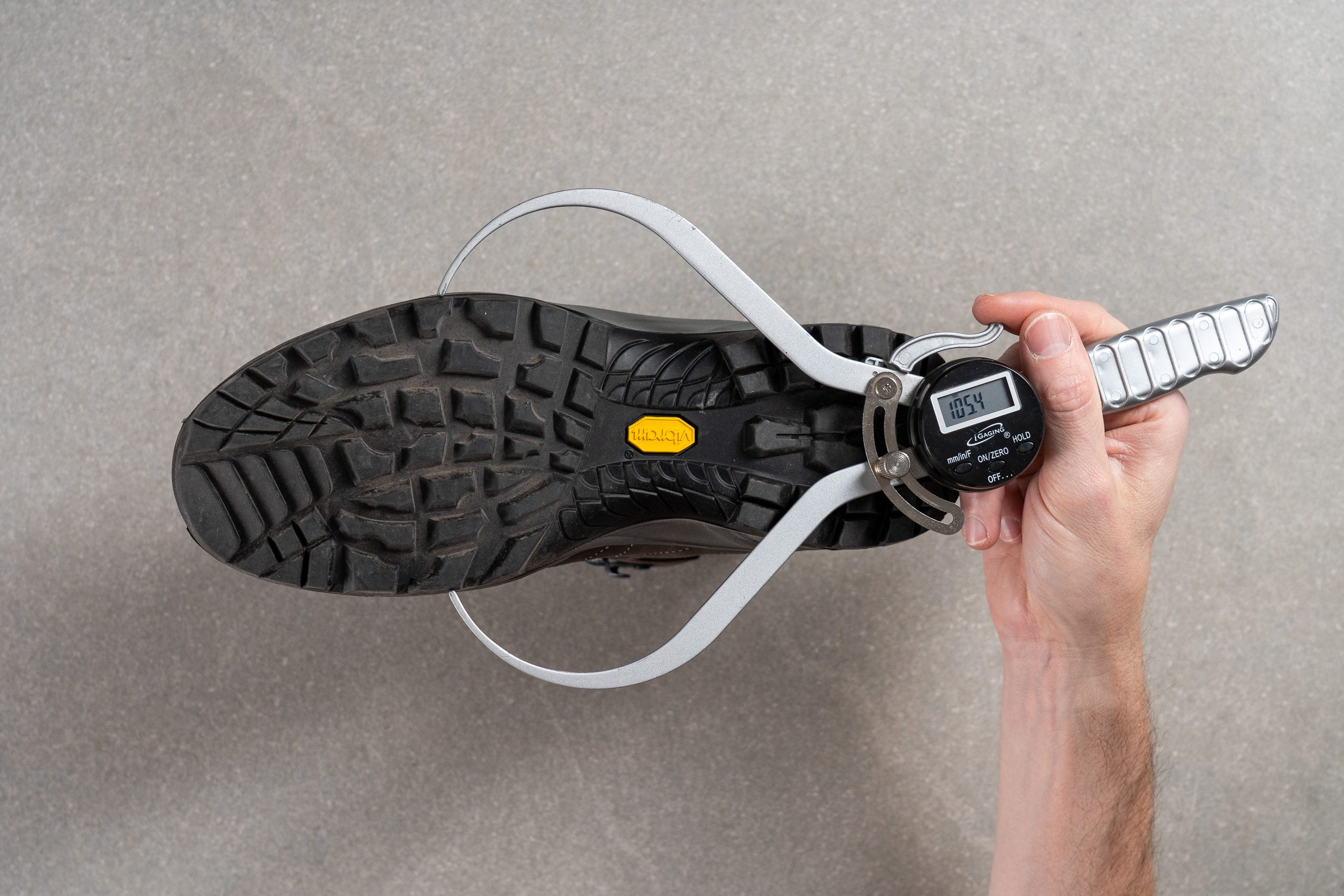
Cuando medimos su punto más ancho con nuestro calibre, marcó 105,4 mm, ¡así que es 6 mm más estrecha que la media! Sin embargo, esto no pareció afectar en absoluto a nuestra pisada.
| Mistral GTX | 105.4 mm |
| Media | 111.5 mm |
Anchura de la mediasuela - talón
En la parte más ancha del talón, las Mistral GTX también miden unos mm menos que la media, pero no lo suficiente como para que nos quejemos. Sus 84,0 mm hacen que sean sobre 3,5 mm más estrechas que la mayoría de las botas.
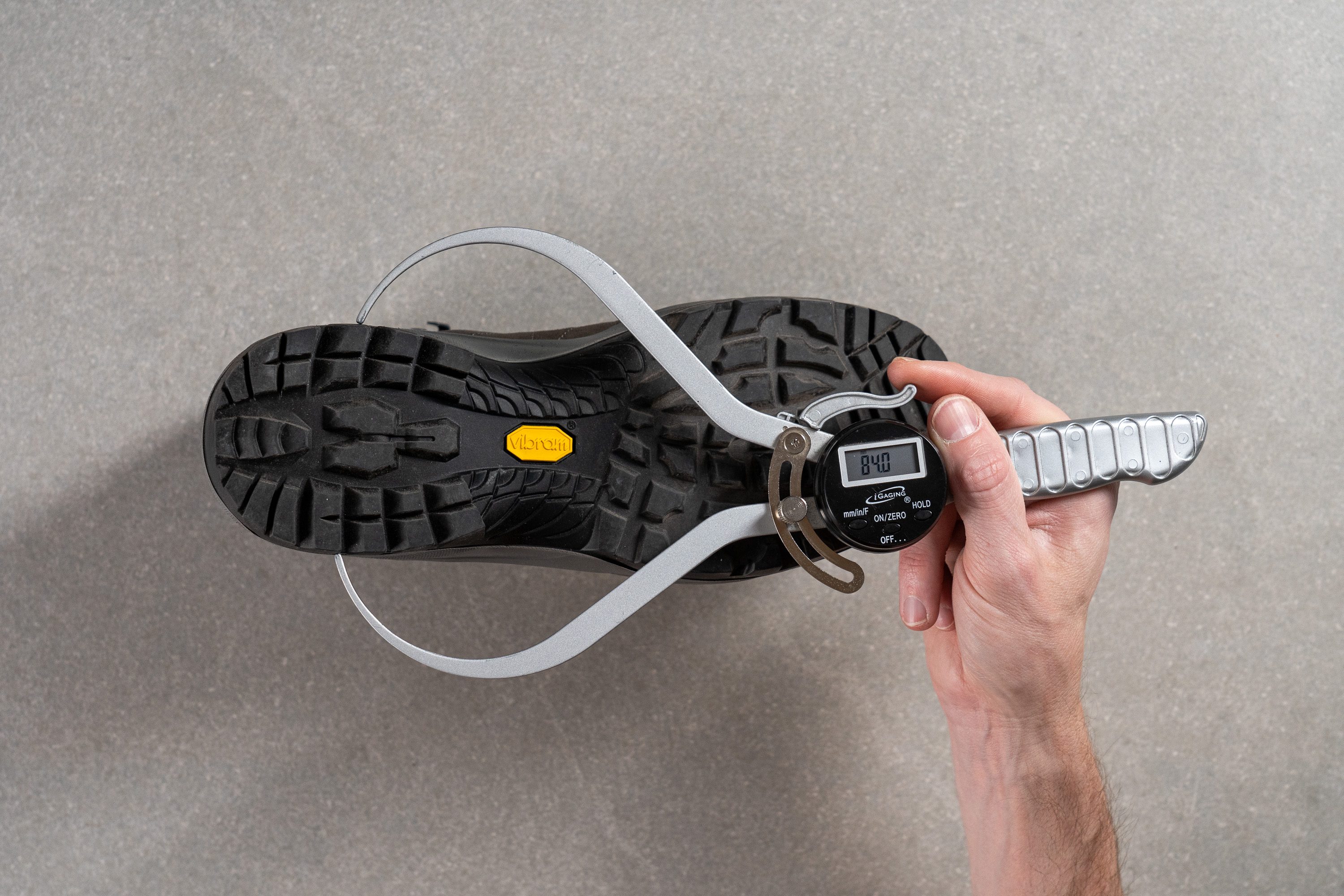
Teniendo en cuenta todo lo que pesan, nos tiene todo el sentido del mundo que la marca intentase reducir el volumen en la medida de lo posible.
| Mistral GTX | 84.0 mm |
| Media | 87.6 mm |
Durabilidad
Durabilidad de la parte delantera
Como Scarpa tiene una reputación excelente en cuanto a durabilidad, nuestras expectativas estaban por las nubes. ¡Y las Mistral GTX han conseguido estar a la altura!
Le dimos caña a la parte delantera de ante de estas zapatillas con el Dremel durante 12 segundos a una velocidad de 5K RPM y una presión de 3,2 N. Es importante señalar que siempre hacemos esta prueba en el mismo punto, sean las que sean las zapatillas que estamos analizando; y Scarpa eligió reforzar esta zona con una capa extra de ante en las Mistral GTX.
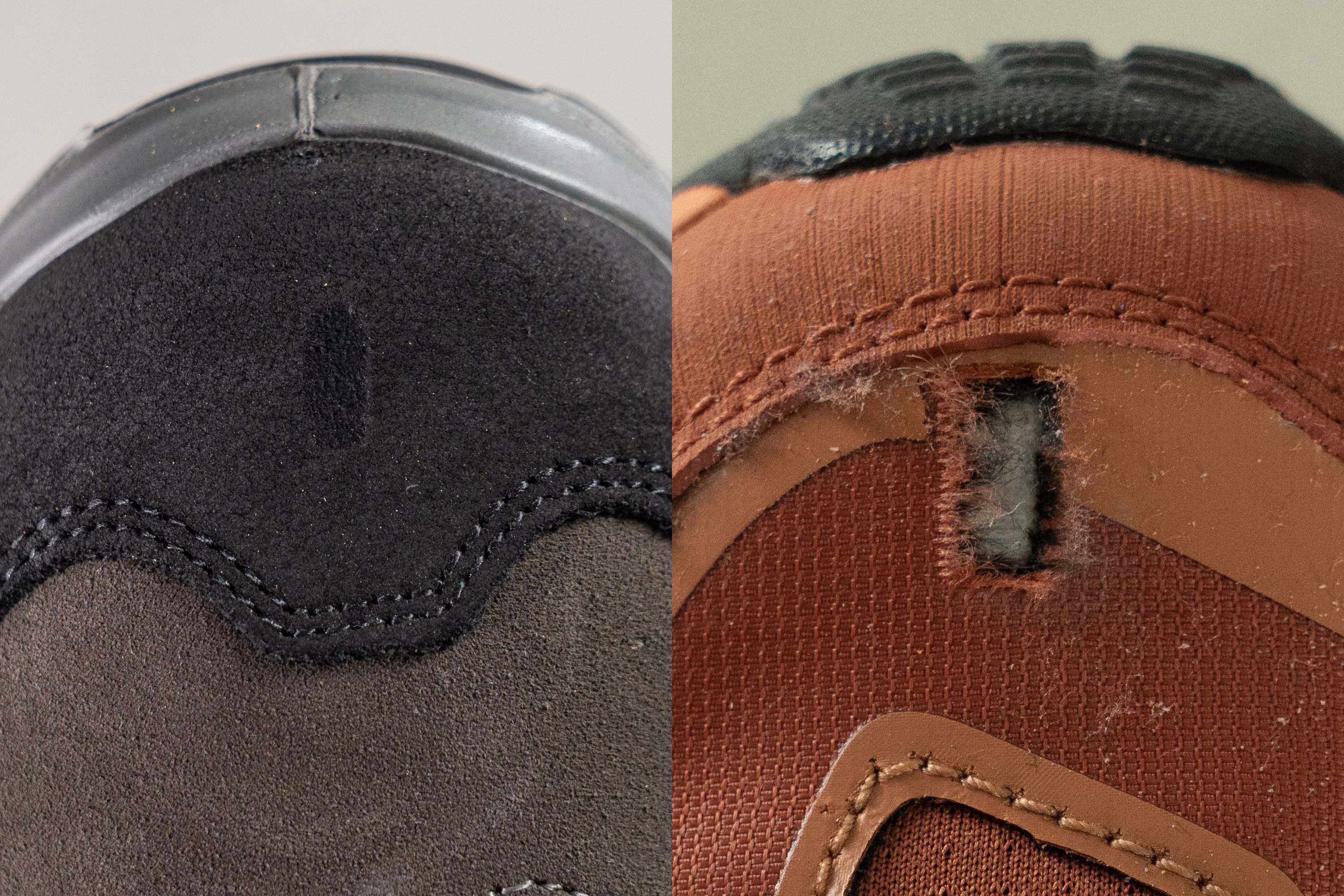
Como puedes ver, las Scarpa terminaron con un rasguño mínimo. El ante que tienen es muy resistente al desgaste, así que no hemos tenido ni una duda al darles la máxima puntuación en durabilidad de la parte delantera: un 5/5.
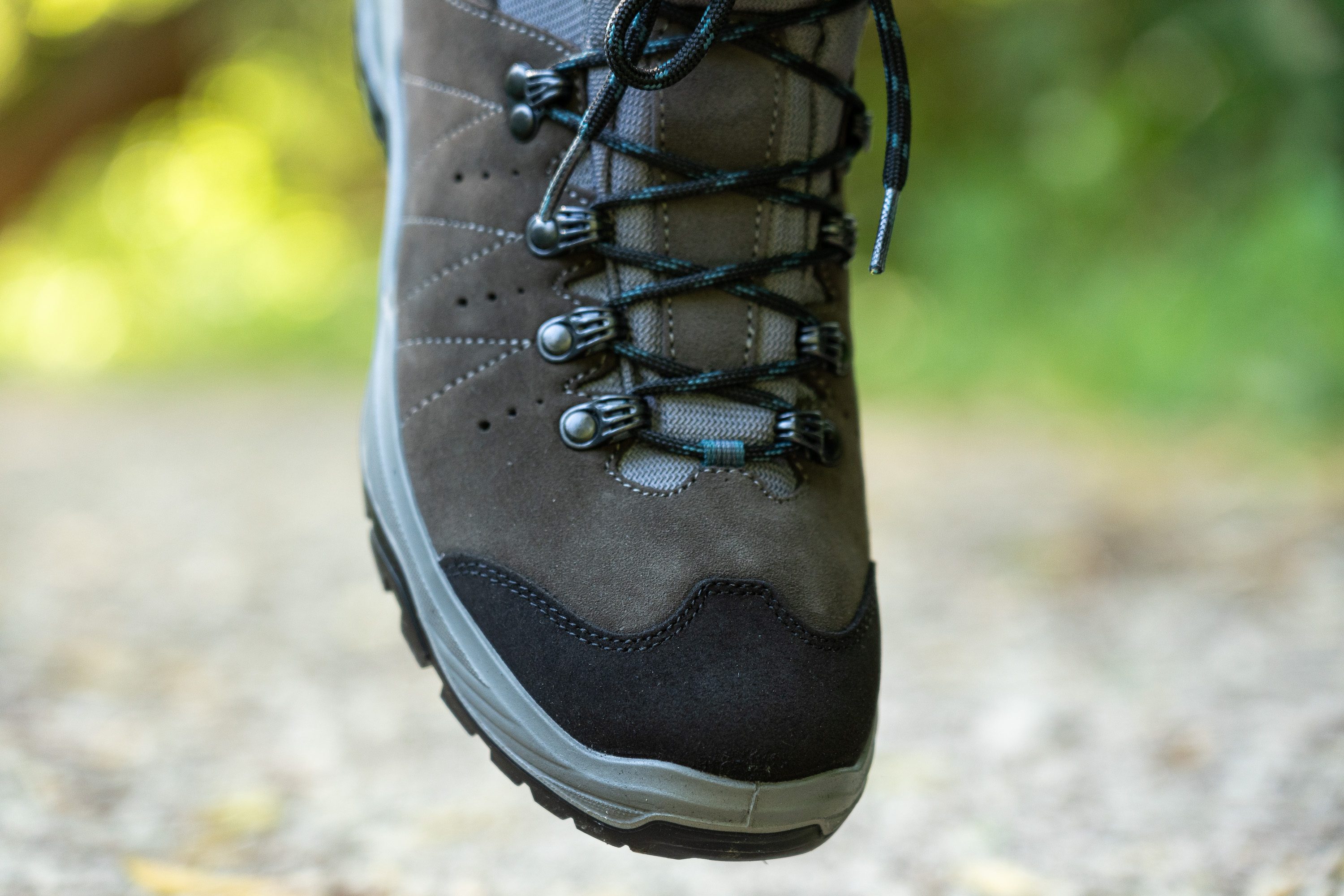
Con una parte delantera tan resistente y grande, ¡las Mistral GTX no le tienen miedo ni a los arbustos ni a las rocas!
| Mistral GTX | 5 |
| Media | 4.3 |
Durabilidad del acolchado del talón
Sin embargo, el forro interior de estas Scarpa nos demostró que no estaba tan preparado para resistir el desgaste.
Nuestro Dremel solo tardó 4 segundos en hacerlo picadillo. Teniendo en cuenta que las botas de senderismo se llevan, de media, una puntuación más bien alta en la durabilidad del acolchado del talón (un 4/5), que las Mistral GTX se hayan llevado solo un 2/5 nos dice que hay bastante margen de mejora.
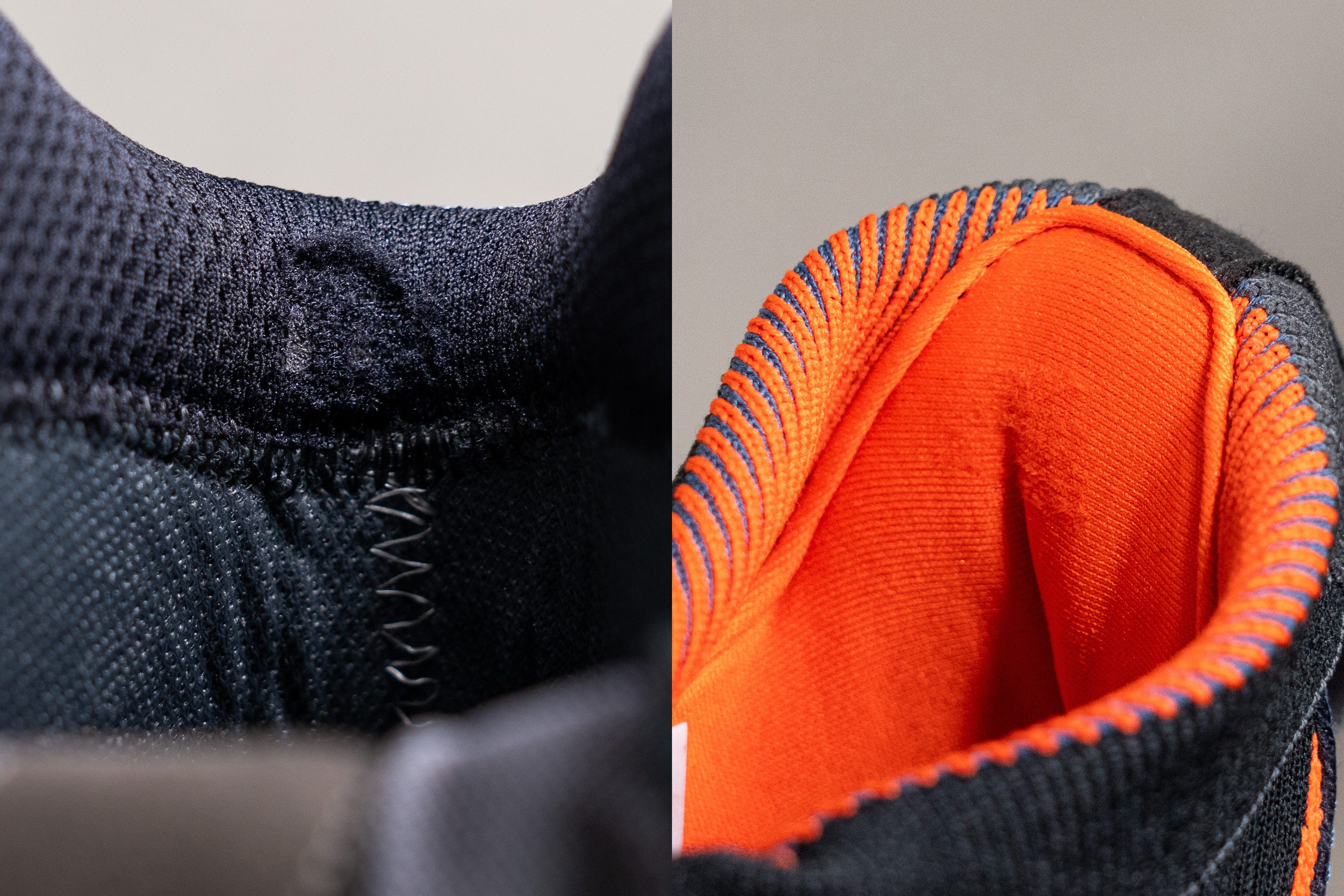
| Mistral GTX | 2 |
| Media | 3.6 |
Dureza de la suela
Por otro lado, la suela exterior Vibram de estas botas nos demostró que es muy robusta.
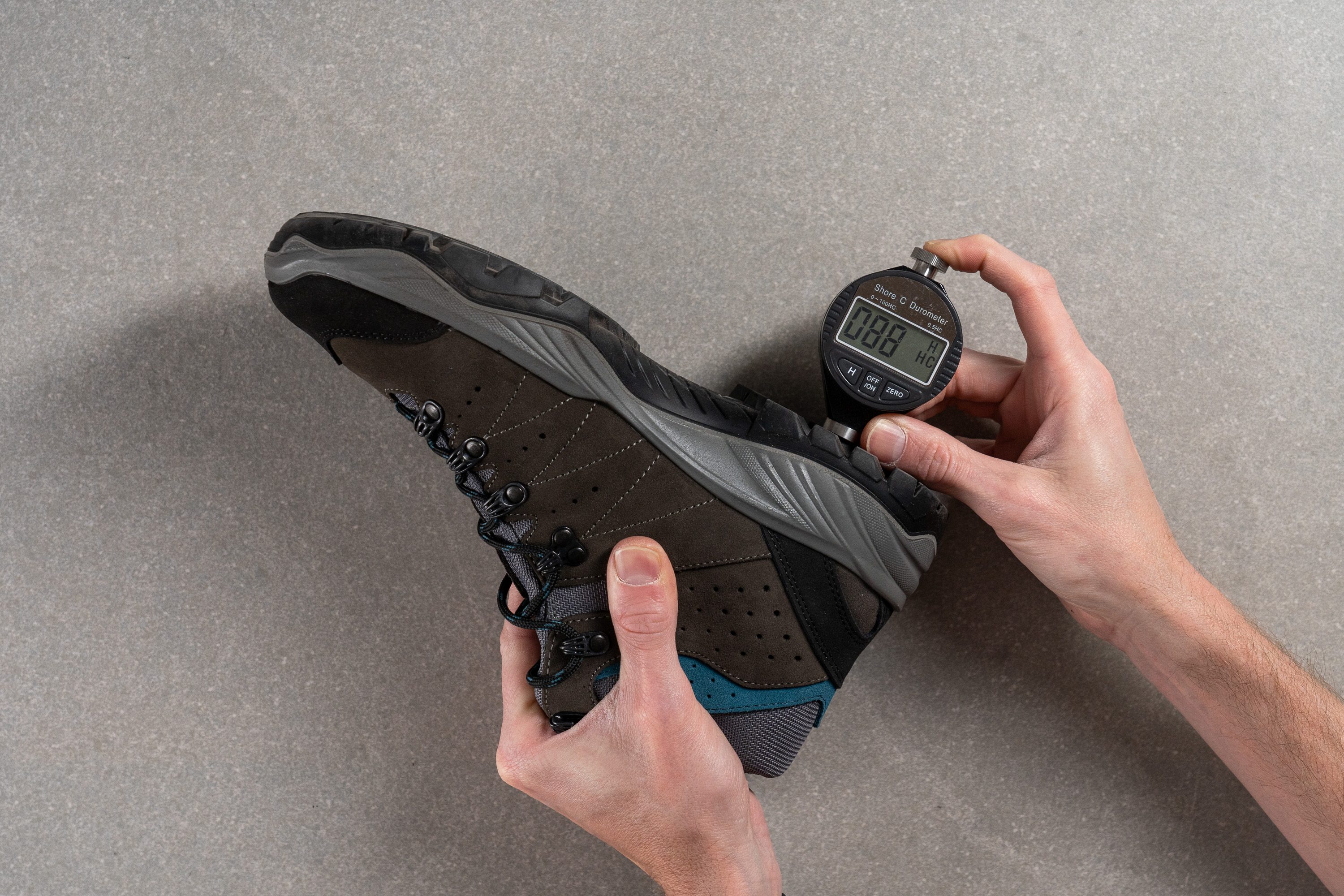
Nuestro durómetro marcó 88,0 HC cuando medimos la dureza de su caucho, un resultado que está a la par con la media del sector.
| Mistral GTX | 88.0 HC |
| Media | 87.1 HC |
Durabilidad de la suela
Pero la dureza no siempre garantiza que la suela vaya a ser duradera, por eso hacemos dos pruebas distintas.
Teniendo en cuenta que el caucho es mucho más resistente que los materiales de la parte superior, subimos el listón aumentando la velocidad de nuestro Dremel a 10K RPM y ampliando la duración de la prueba a 22 segundos.
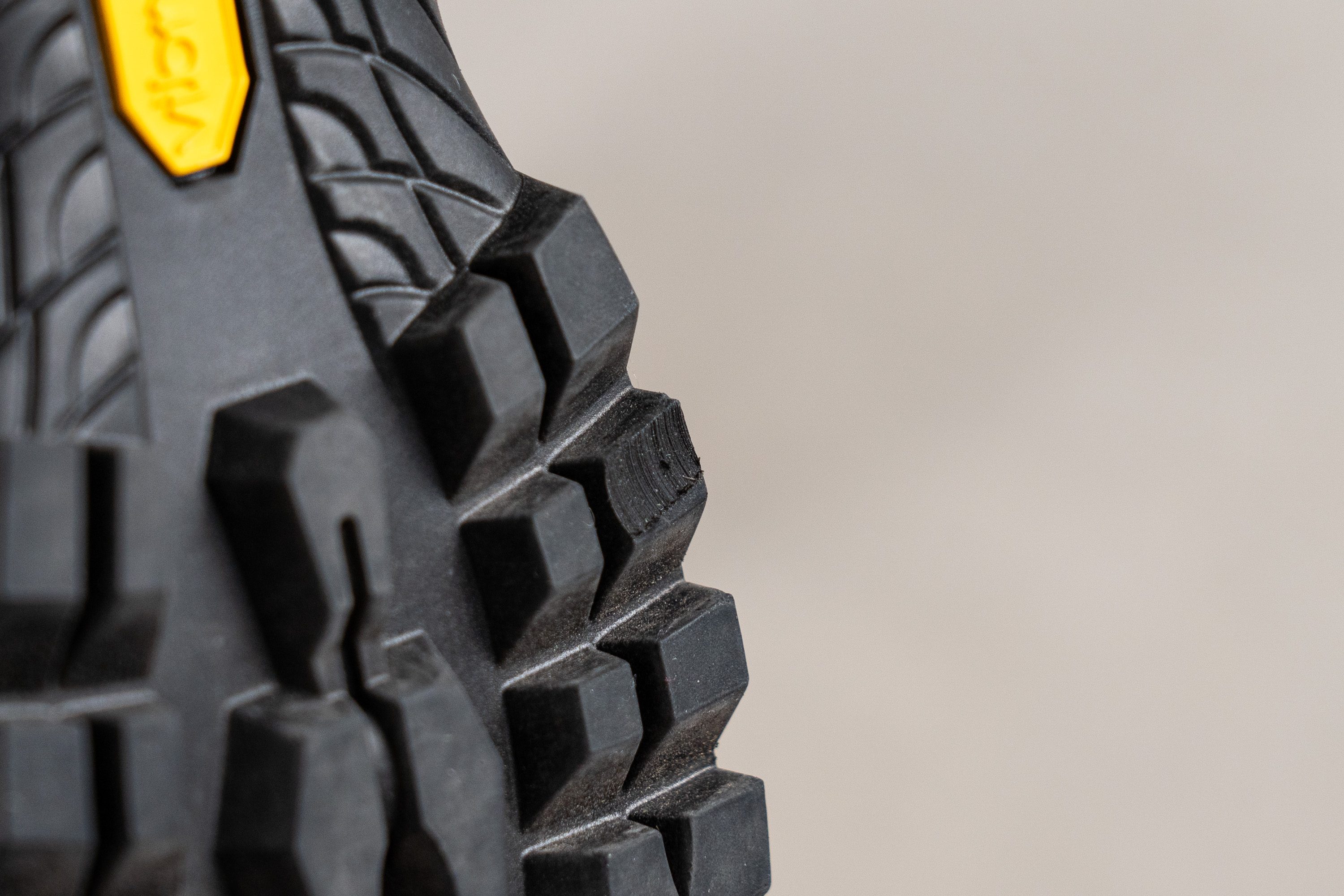
Pero unas condiciones más estrictas no cambiaron el hecho de que la suela exterior de caucho de las Mistral está preparada para que le des mucha caña. Nuestro medidor de desgaste de neumáticos indicó que los daños realizados por el Dremel solo llegaban a los 0,8 mm de profundidad, que es un resultado sólido para unas botas de senderismo.
| Mistral GTX | 0.8 mm |
| Media | 0.8 mm |
Grosor de la suela
Las Scarpa Mistral GTX tampoco escatiman en el grosor de la suela exterior. Nuestro calibre marcó 3,0 mm, un resultado estándar para las botas de senderismo.
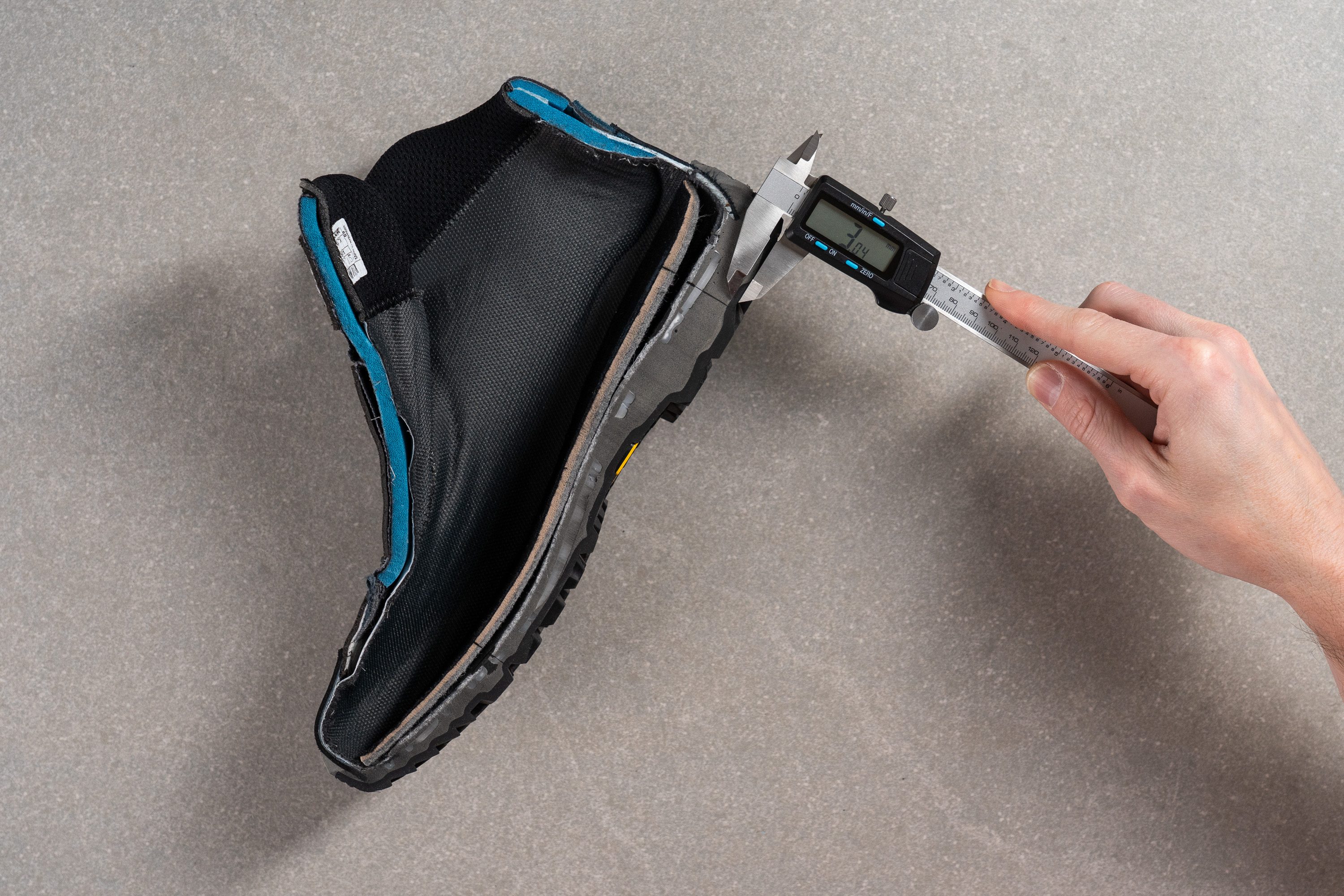
Vamos, que estas tres pruebas nos confirman que la suela exterior de estas Scarpa está a la altura de los estándares del sector en cuanto a dureza, resistencia a la abrasión y grosor. Por lo tanto, esperamos que dure tanto como la media.

| Mistral GTX | 3.0 mm |
| Media | 2.9 mm |
Varios
Grosor de la plantilla
Una plantilla bien acolchada ofrece una fina capa de amortiguación entre la rígida plataforma de las zapatillas y los pies.
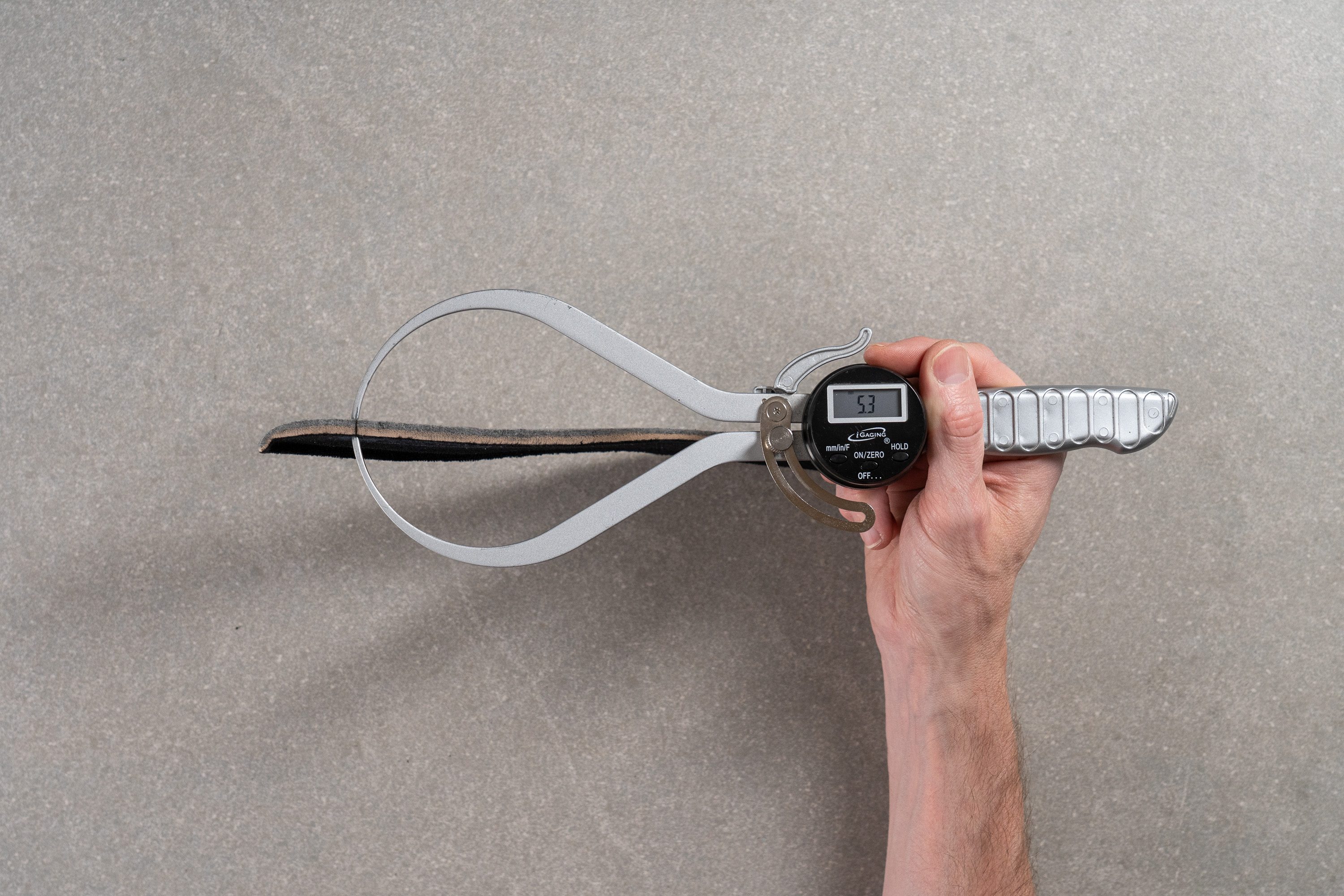
Nuestro calibre marcó 5,3 mm cuando medimos su grosor, que es estándar para unas botas de senderismo.
| Mistral GTX | 5.3 mm |
| Media | 6.0 mm |
Plantilla extraíble
Puedes cambiar la plantilla por otra si necesitas más soporte para el arco del pie o amortiguación.

| Mistral GTX | Sí |
Rigidez de la mediasuela en frío (%)
Por suerte, las Mistral GTX no se vuelven mucho más firmes cuando caen la temperaturas.
Para comprobarlo, las metimos en nuestro congelador durante 20 minutos.
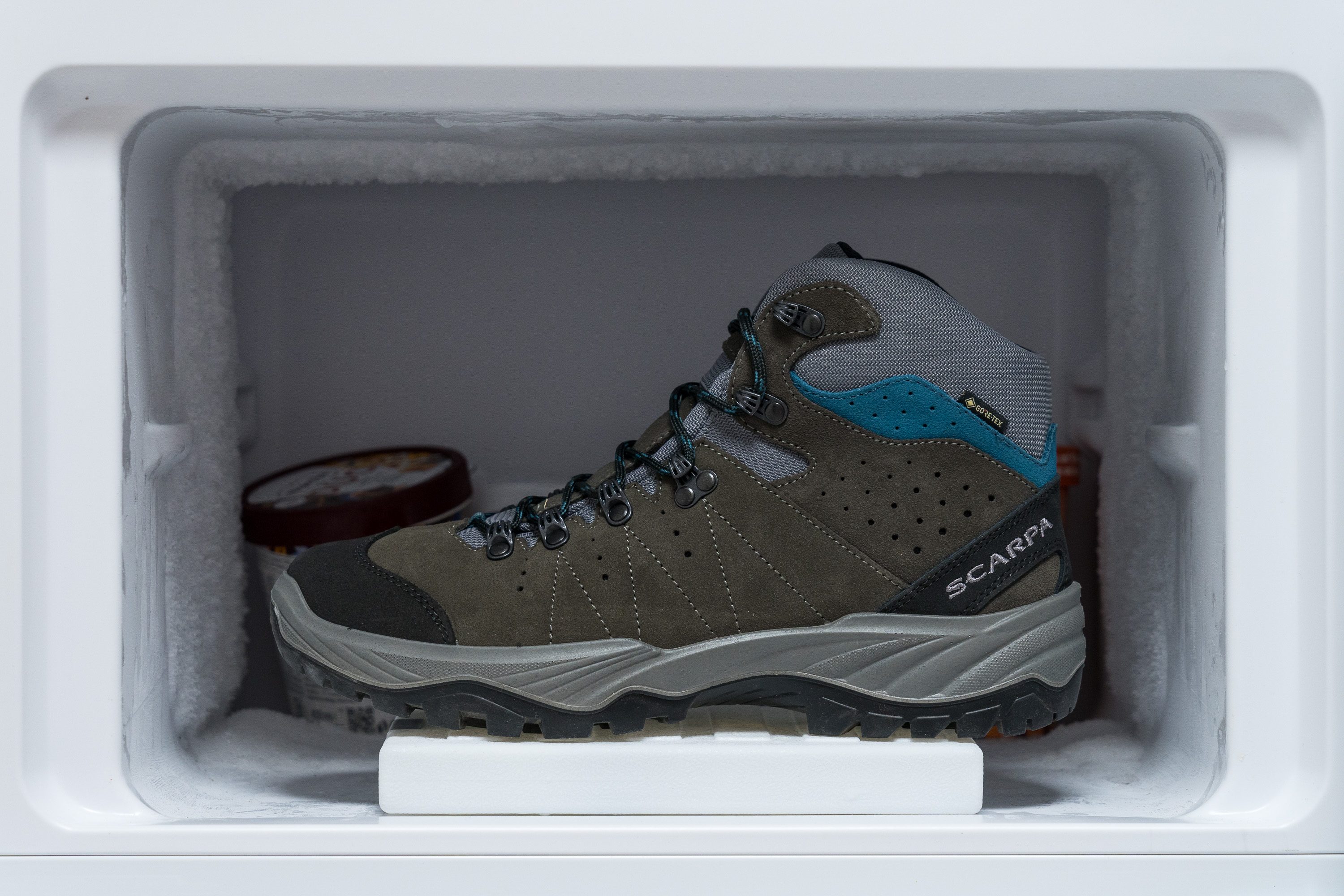
Después volvimos a analizarlas con nuestro durómetro, y comprobamos que la espuma solo se había vuelto un 11,6 % más firme.
| Mistral GTX | 12% |
| Media | 20% |
Elementos reflectantes
Estas botas de Scarpa no tienen elementos reflectantes.
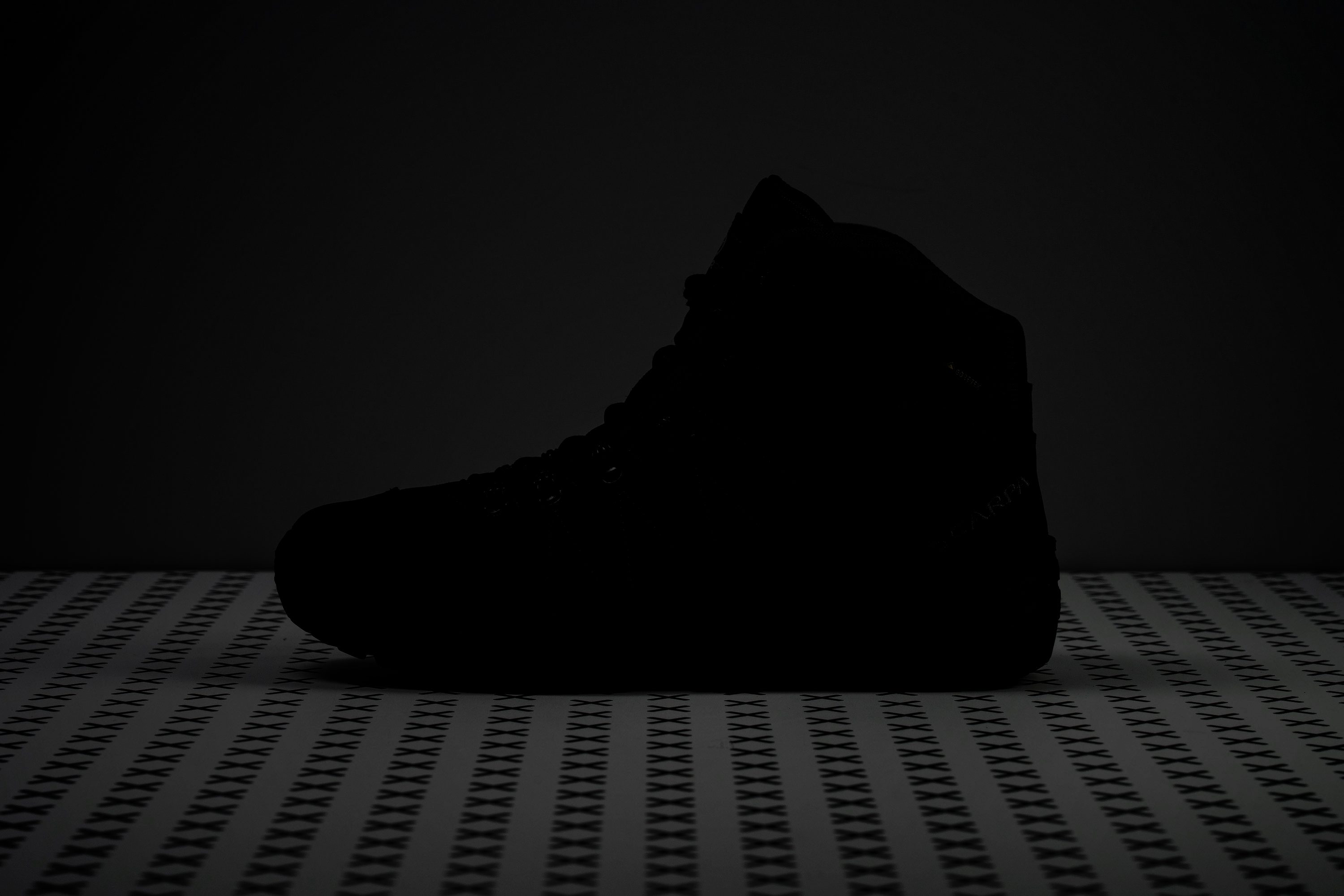
| Mistral GTX | No |
Acolchado de la lengüeta
La lengüeta bien acolchada de estas botas hizo que fuesen incluso más cómodas.
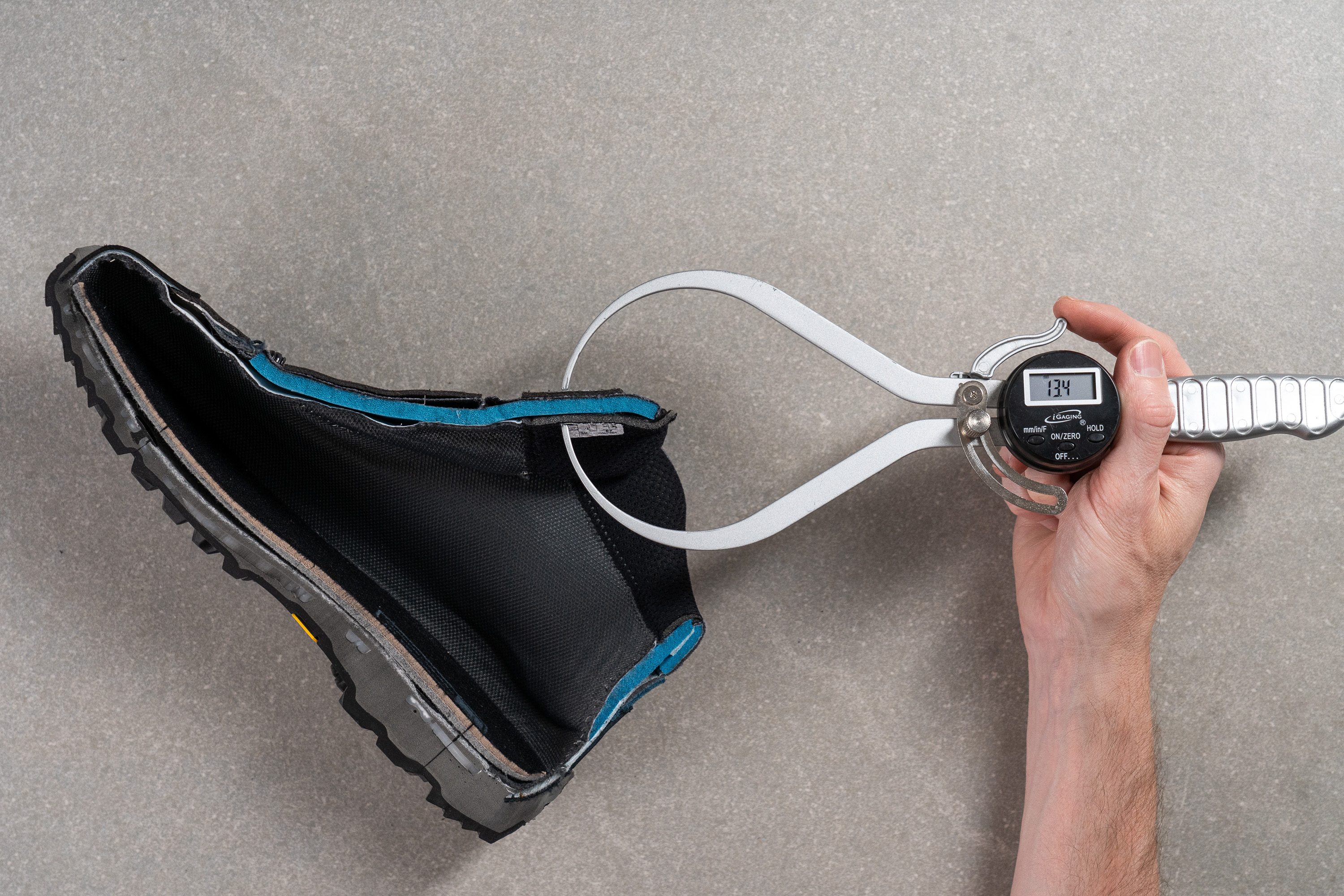
Con un grosor de 13,4 mm, está hasta más acolchada que la media.
| Mistral GTX | 13.4 mm |
| Media | 11.2 mm |
Lengüeta: tipo de refuerzo
Las Mistral GTX maximizan su impermeabilidad con la ayuda de una lengüeta totalmente integrada y, como puedes ver, los refuerzos se extienden casi hasta la altura del cuello.
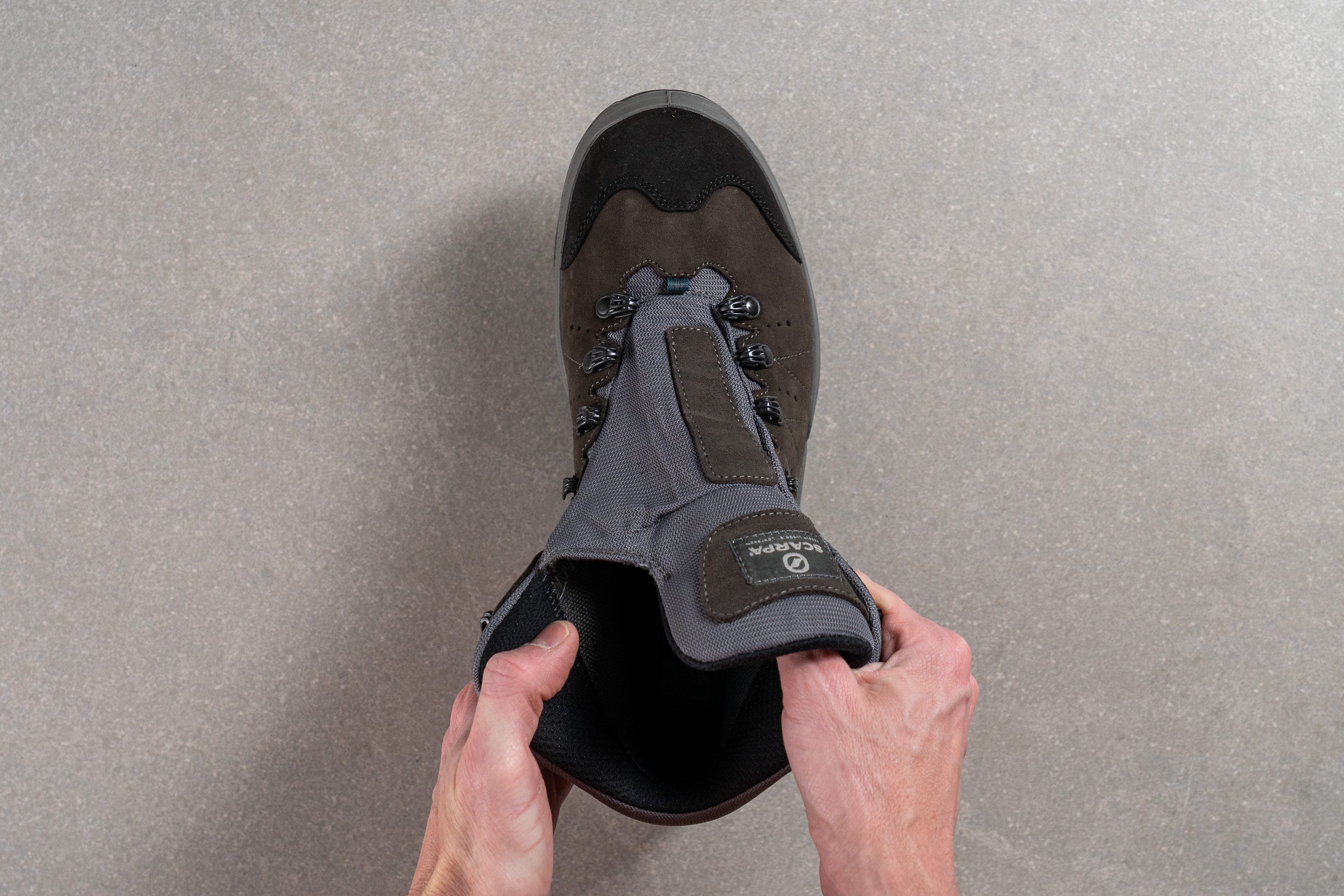
Esta característica hace que no te tengas que preocupar tanto por los charcos profundos o los arroyos con los que te cruces. Solo te tienes que asegurar de que el agua no te llegue hasta la zona donde no hay refuerzo, porque si se te mete dentro de las botas, se te quedarán húmedas por dentro durante todo lo que te queda de ruta.
| Mistral GTX | Ambos lados (completo) |
Tirador del talón
Incluso sin tirador para los dedos, ponernos y quitarnos estas botas no nos costó nada. La boca se les abre lo suficiente, además de que los ojales hacen que lidiar con los cordones sea más sencillo.
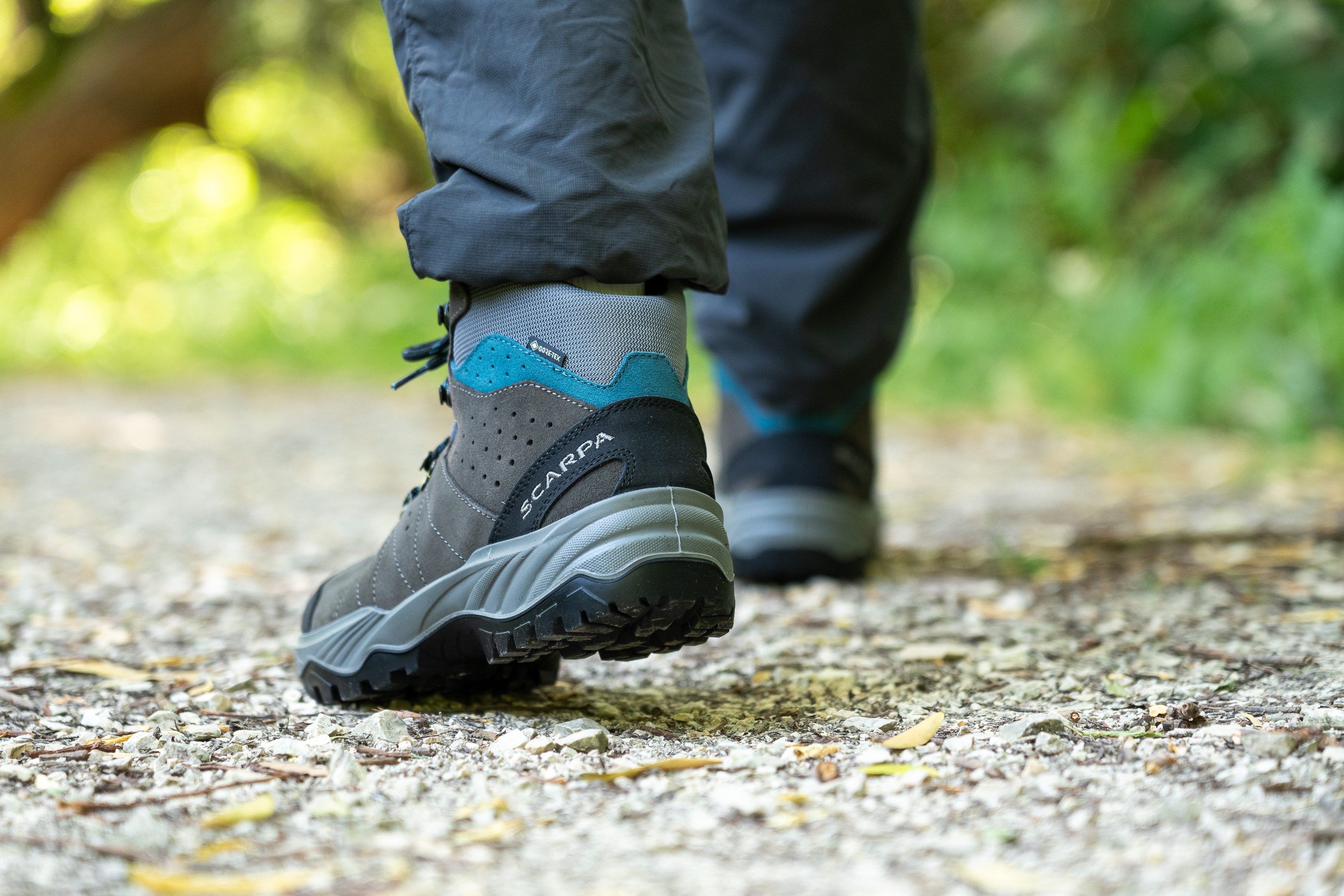
| Mistral GTX | Ninguno |

